

Kyoto Open-Top Bus - Freely Hop On and Hop Off
Sky hopbus .kyoto.
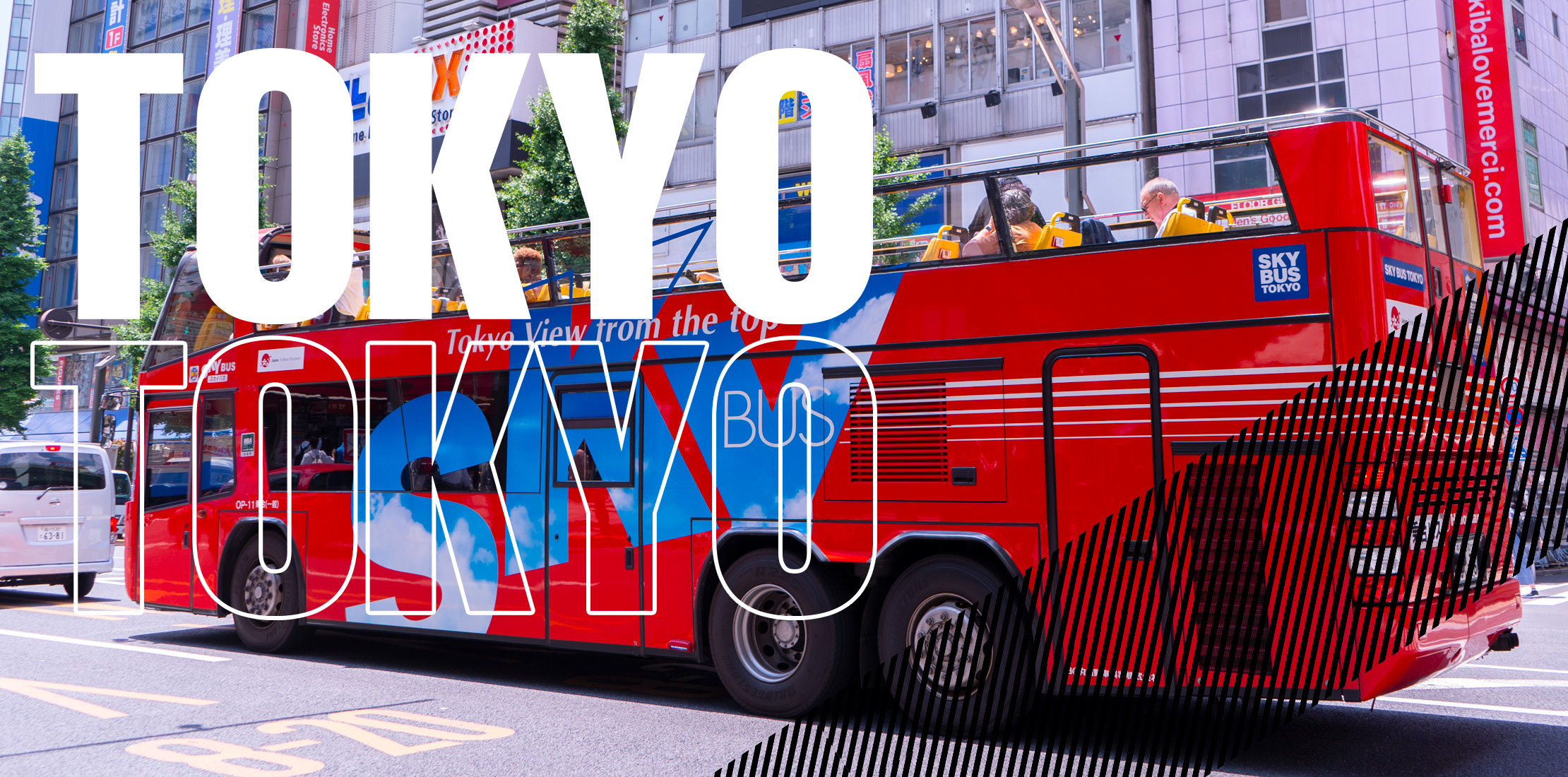
The "Sky Hop Bus" is a red, double-decker, open-top sightseeing bus that offers tours around Kyoto where you can get on and off whenever you like. You can take in famous sightseeing spots right from your seat on its spacious and roofless upper deck. Gaze over Kyoto's beautiful scenery, get off at any sightseeing destination that grabs your interest, wander around, eat, play, and then get back on. Freestyle your Kyoto tour and take your fill of everything it has to offer.

A First-Hand Experience of this Historic Townscape
The Sky Hop Bus is a spacious, roofless, open-top bus. From the comfort of your seat on the upper deck, you'll enjoy the sights of Kyoto's famous landmarks and historic sites, such as Nishiki Market, Nijo Castle, Kinkakuji Temple, Ginkakuji Temple, Heian-Jingu Shrine, Kiyomizudera Temple, and so on. Kyoto is a place where even the buildings will give leave you longing for its halcyon days. There's also a plethora of photo spots you can snap pictures of right from the bus window.
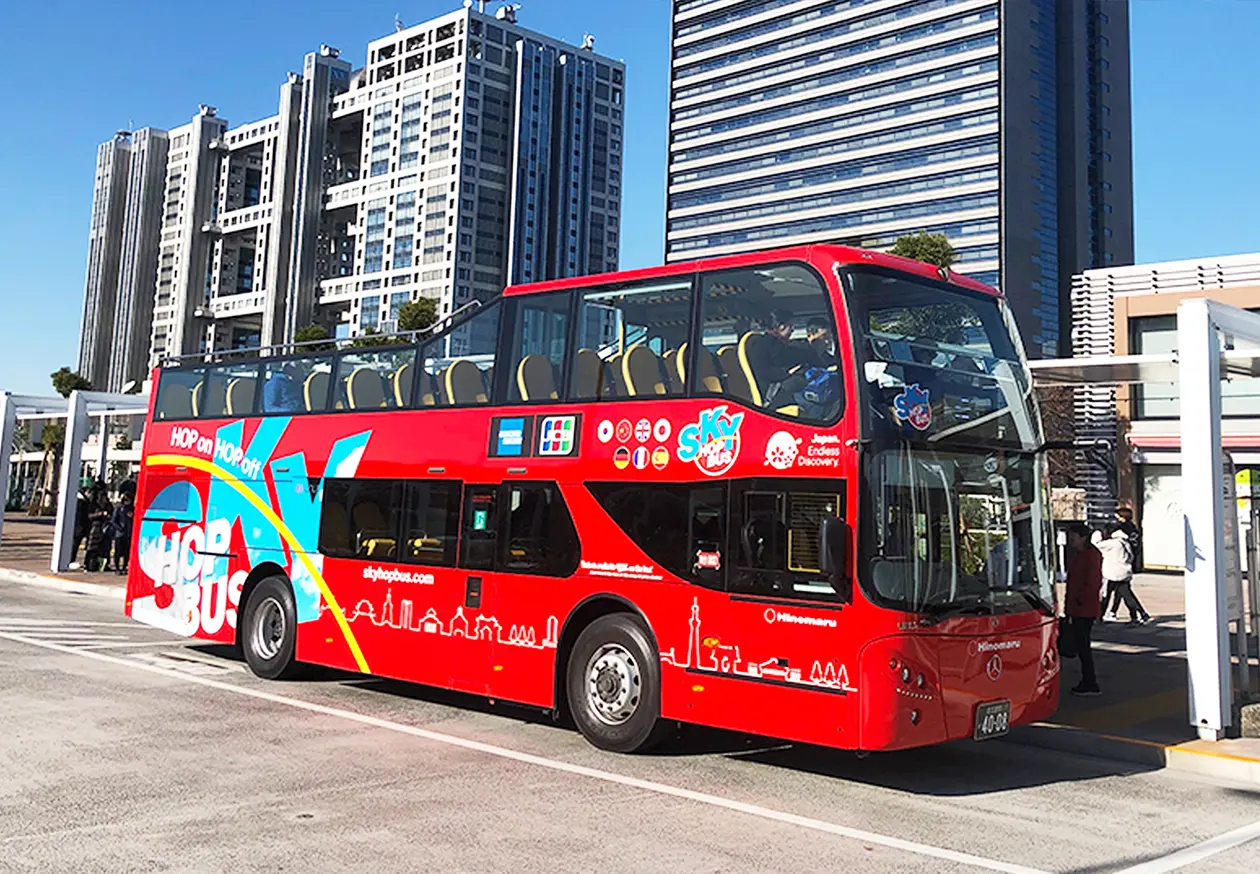
Freely Hop On and Hop Off
No roof and no schedule.
The Hop-on Hop-off Bus Route is a bus tour where you get on and off whenever you like. You can hop on and off the bus as many times as you want at any of the stops, giving you the freedom to plan your own sightseeing itinerary. Enjoy the sights on the upper deck right from the bus window, hop off when you're near your sightseeing destination, and get back on whenever you like. Take this pleasant cruise around the many must-see attractions Kyoto has to offer, and if a particular spot catches your interest, feel free to get off and walk around. You can enjoy sightseeing at your own pace.

A Complete Audio Guide
Dive even deeper into kyoto's history.
Free audio commentaries are available for a variety of different sightseeing destinations. If you put on our provided earphones, you can listen to a fun, in-depth commentary from a guide who knows all there is to know about Kyoto. The audio guide is available in Japanese, English, Chinese, Korean, Spanish, French, and German. Additionally, thanks to its GPS technology, the audio commentary will start to play with perfect timing when a must-see attraction is near. Wouldn't you like to give your ears a taste of these charming attractions too?
This route travels around Kyoto's iconic spots, such as famous places, shrines, and temples. You can freely get on and off at any stop. If you get off close to somewhere you'd like to explore, please feel free to enjoy other sightseeing spots in the area as well.
View Larger Map
Course Guide
This route offers the chance to experience all the charm packed into the former capital of Japan. Destinations include: Nishiki Market, often referred to as the "Kitchen of Kyoto;" Nijo Castle, a certified World Heritage Site; Kinkakuji Temple, famous for its shining golden reliquary hall; Ginkakuji Temple, which showcases the "wabi-sabi" culture of Kyoto's Higashiyama district; Heian-Jingu Shrine, which is famous for its large torii gate; and Kiyomizudera Temple, also known as Kiyomizu Stage.
Kyoto Course
1. kyoto station, karasuma exit, 2. nishihonganji temple (kyoto tokyu hotel), 3. shijo karasuma/nishiki market.
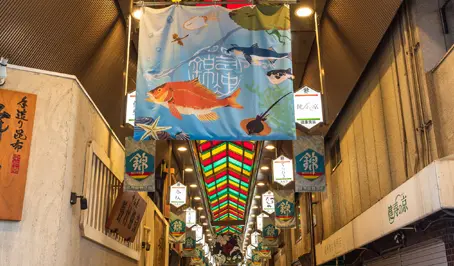
4. Nijo-jo Castle
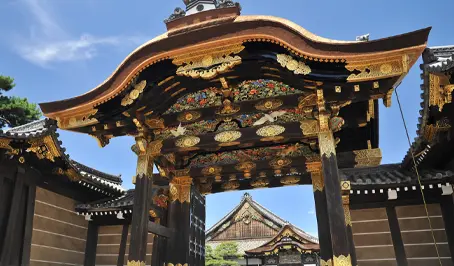
6. Kitano Tenmangu Shrine / Kamishichiken
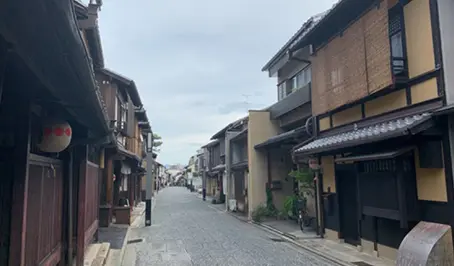
7. Kinkaku-ji Temple
8. daitoku-ji temple, 9. kyoto imperial palace (in front of doshisha univ.).
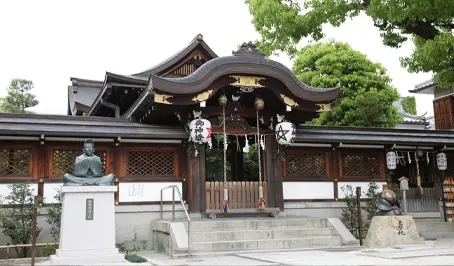
10. Ginkaku-ji Temple
11. heian-jingu shrine / okazaki park.
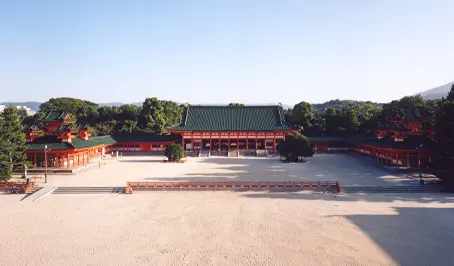
12. Gion(Kotowa-Kyoto Yasaka)
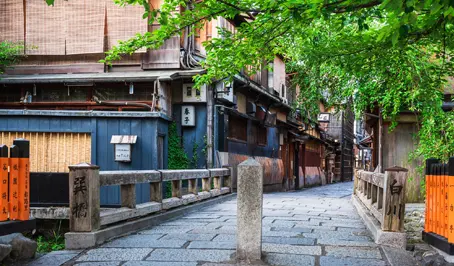
13.Gojo-zaka (Kiyomizu-dera Temple)
14. sanjusangendo / kyoto national museum (hyatt regency kyoto).
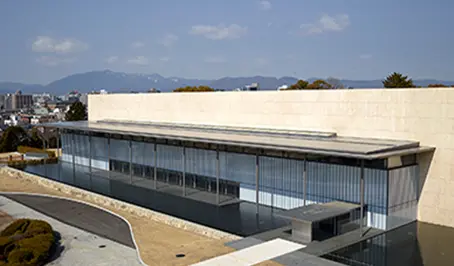
How To Ride with The Sky Hop Bus
Have you decided which tour route you'd like to pick? You can start your tour by getting on a bus from any bus stop you like. Here is our guide on how to ride with the Sky Hop Bus.
Purchasing Tickets and Boarding

Buy your ticket(s) online beforehand, and then get on board at any bus stop.
Getting Off at Bus Stops
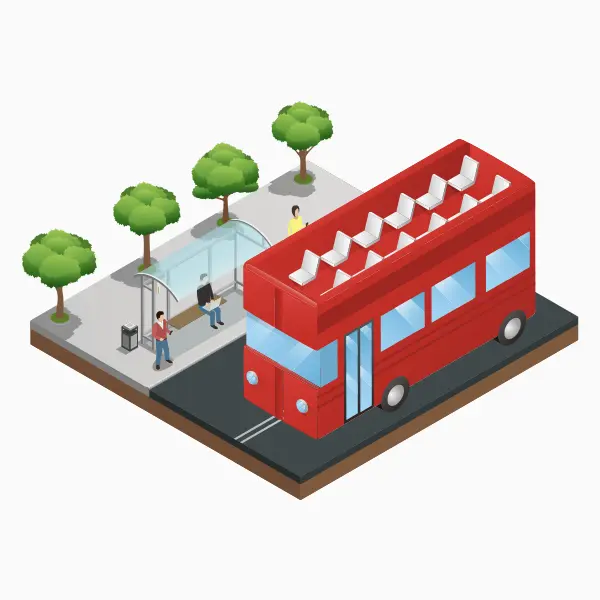
Enjoy sightseeing while riding on the upper deck. Get off at any bus stop.
Walking Around
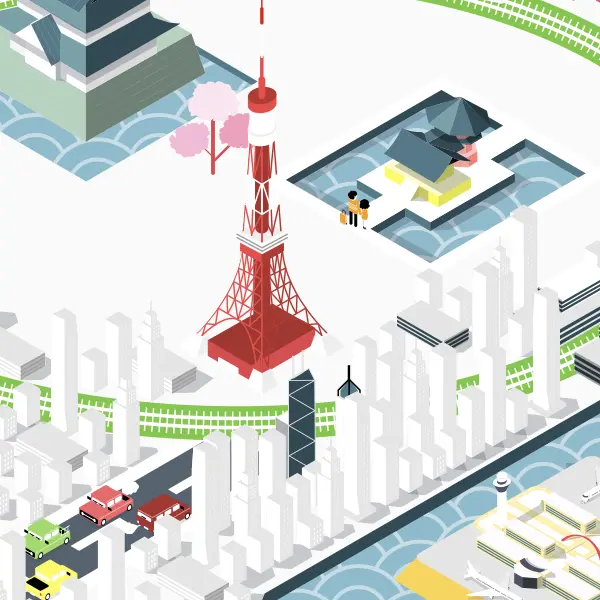
Feel free to sightsee and explore the nearby area of any destination you like, drink tea, etc.
Getting On Again at Bus stops
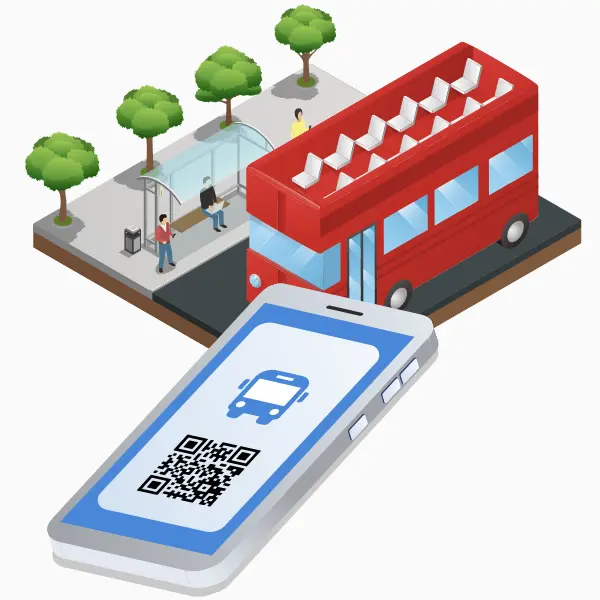
Hold up your ticket's QR code at any bus stop to get back on.
Get a 10% discount by purchasing your tickets online!

The K'LOOP is a Kyoto tourist attractions loop bus.

Kinkakuji Temple Nijo-jo Castle route

Watch the route
Heian Jingu Shrine Kiyomizu route

Arashiyama route

Fushimi Inari Shrine To-ji Temple route

Operating day
It will operate on April 21st (Sunday) and April 28th (Sunday). We look forward to seeing you on board.
K'LOOP is the tourist loop bus for exploring popular tourist attractionsincluding the World Heritage Sites in Kyoto.
The bus travels around "highlite route" such as popular sightseeing attractions you won’t want to miss. It is recommendable for first visit Kyoto!

Exploring 17 places including the World Heritage
Whole day All routes unlimited ride Hop on Hop off

Get on the bus from any bus stops
Connecting sightseeing attractions directly

- Detailed maps of each bus stops
Days of operation
Operates on a designated day. Please see the notice.
Single tickets
- Purchase a one-day pass from the bus information attendant at the Hachijo Gate of Kyoto Station or from the bus crew.
- Payment by cash, WAON, LINE Pay, PayPay is possible. We can't accept payment by credit card and so on. Please understand in advance.
When the bus is full, you might not be able to get in. In this case, please take another bus before and after.
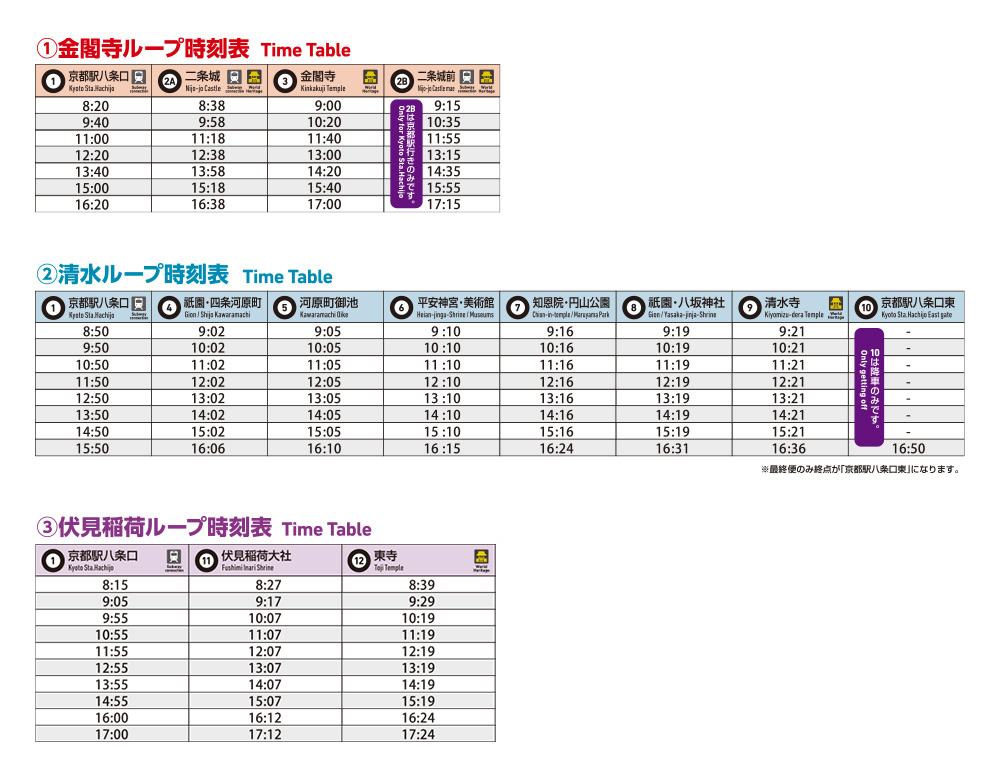
- Bus tracking map
京都・世界遺産回遊バス(k'loop)
- Kyoto World Heritage Loop Bus/ K'LOOP TOP page
- Why K'LOOP is the best choice?
- ** reservation **
Kyoto World Heritage Loop Bus (K'LOOP) / Hop-on Hop-off
- Simple routes, convenient timetable, best choice for exploring Kyoto!
- Bus operations
- Convenient access to:
- Starting points of your trip

Kyoto Bus: Navigating, Maps, And Tips
Navigating Kyoto Bus System
Kyoto offers various bus types to cater to different needs, with one of the most popular being the Raku Bus 100 . This particular route is not only convenient but also a favorite among tourists due to its strategic stops at major attractions throughout the city. If you’re looking for an efficient way to explore Kyoto’s beauty, hopping on the Raku Bus 100 might be your best bet.
- Convenient and popular among tourists
- Stops at major tourist attractions
- Ideal for exploring the city without missing key sights
There are multiple options available. You can opt for traditional cash payments directly onboard or utilize modern solutions like IC cards[ 1 ] such as Suica or Pasmo. The flexibility in payment methods means you don’t have to worry about purchasing tickets beforehand; simply choose what works best for you when boarding the bus.
- There are limited alternatives if you forget cash or IC card
- Some visitors may find using IC cards challenging initially
Kyoto’s bus system operates on a fare structure that aims to be both simple and affordable for passengers. Most routes follow a flat fare system , making it easy for travelers regardless of their destination within the city. However, keep in mind that fares may vary based on how far you travel, ensuring fair pricing while still offering budget-friendly rates overall.
- Flat fare system simplifies payments
- Fares depend on distance traveled
- Affordable prices suitable for all passengers
The operational hours of Kyoto buses provide ample opportunities for exploration from early morning until late evening each day. While specific timings might differ depending on the route taken, rest assured that whether you’re an early riser eager to start your day or a night owl enjoying Kyoto’s evening ambiance, there will likely be a bus schedule accommodating your plans.
Understanding Bus Maps
Bus maps for Kyoto can easily be obtained from official websites or apps. These maps are crucial, as they provide a clear overview of bus routes and stops. By having access to these maps, travelers can effectively plan their journey in advance, making it easier to navigate the city’s bus system.
Downloading bus maps is beneficial because it allows individuals to familiarize themselves with the various bus lines available in Kyoto. This knowledge helps passengers identify which buses to take based on their destination and preferred route. Understanding the bus network through these maps ensures a smoother and more efficient travel experience for visitors exploring Kyoto.
- Convenient access to bus routes
- Helps in pre-planning journeys
- Enables efficient navigation throughout the city
A district map offers an insightful glimpse into the different areas of Kyoto, highlighting key attractions within each district. Travelers can use this map to gain a better understanding of what each part of the city has to offer, aiding them in deciding which districts align with their interests or sightseeing preferences.
District maps serve as valuable tools when planning an itinerary, as they showcase popular landmarks and sights unique to specific areas in Kyoto. With this information at hand, tourists can prioritize visiting districts that appeal most to them, ensuring they make the most out of their time exploring the diverse cultural and historical offerings scattered across Kyoto.
- Provides an overview of distinct districts
- Highlights the main tourist attractions
- Assists travelers in choosing areas to visit
The comprehensive route map displays all bus lines operating within Kyoto, along with details about stops along each route. This visual representation aids passengers by illustrating how different routes intersect and connect throughout the city, facilitating seamless navigation from one location to another via public transportation.
Route maps are essential resources for those looking to explore various parts of Kyoto using its extensive bus network efficiently. By studying these detailed maps before embarking on their journey, visitors can feel more confident navigating through unfamiliar streets while relying on public buses as a convenient mode of transportation during their stay.
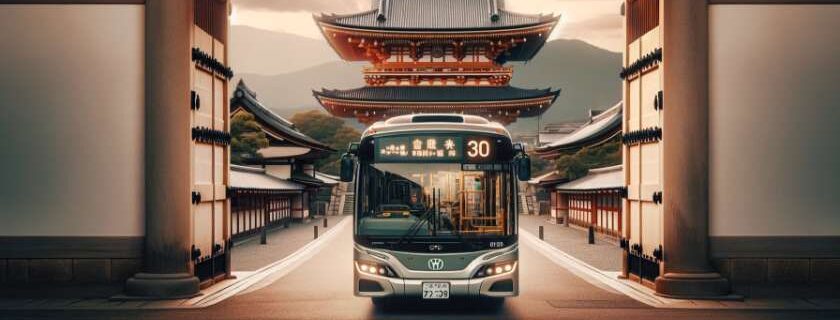
Using Kyoto City Bus Effectively
Kyoto City Bus has flat fare routes where you pay the same amount no matter how far you go. This is perfect for short trips within a specific area, like hopping between nearby temples or shrines. These routes are great money-savers compared to variable fare options.
When using flat fare routes, consider visiting popular spots in close proximity, such as Gion District and Kiyomizu-dera Temple. With a fixed fee for each ride, exploring these areas becomes budget-friendly and hassle-free.
- Cost-effective for short distances
- Convenient for quick sightseeing tours
On the other hand, non-flat fare routes calculate your fee based on the distance traveled. If you’re planning to visit attractions spread across different parts of Kyoto, this option might be more suitable. The longer your journey, the higher the fare will be due to increasing distance coverage.
For longer journeys around Kyoto that involve traveling from one end of the city to another, non-flat fare routes provide flexibility but may cost more than flat-rate options in certain scenarios.
- More expensive for extended travels
- Pricing varies depending on distance covered
If you’re looking to explore multiple sites in a day without worrying about individual fares, consider purchasing day pass tickets offered by Kyoto City Bus. These tickets allow unlimited rides within a day at a fixed price point. They are available at ticket vending machines located at major bus stops or information centers throughout the city.
Day passes can be an excellent choice when planning an itinerary with several locations on your agenda: think Fushimi Inari Taisha Shrine in the morning followed by Arashiyama Bamboo Grove later in the day—all covered under one cost-efficient daily pass!
- Purchase day pass tickets from designated vending machines.
- Enjoy unlimited bus rides throughout Kyoto within a single day.
- Make sure to validate your ticket upon boarding each bus during your explorations.
Tips for Riding Kyoto City Bus
When taking the Kyoto bus , make sure to wait at the designated stops for your desired route. Once the bus arrives, queue up and board promptly. Remember to show your ticket or IC card to the driver as you enter.
Boarding a bus in Kyoto is simple; just be attentive to your surroundings, follow the line, and have your fare ready. This way, you can ensure a smooth boarding process without any delays.
To get off at your stop, press the stop button or pull the cord before reaching it. Exit through the rear door of the bus smoothly and efficiently. Always consider other passengers while disembarking by moving swiftly but politely.
When getting off a crowded Kyoto city bus, signaling ahead of time helps both you and other passengers prepare for stops effectively. By doing so, you contribute to maintaining an orderly flow during exits.
Practice good manners on Kyoto buses by offering your seat to elderly or disabled individuals when needed. Keep noise levels low during rides and refrain from engaging in phone conversations inside buses. Dispose of trash correctly in the provided bins within buses; this ensures cleanliness onboard for all passengers throughout their journey.
Discount Passes And Ticketing
Tourists in Kyoto can benefit from various discount passes when using the city bus. These passes typically offer discounted fares or unlimited rides , catering to different travel needs. For example, the Kyoto City Bus and Subway Pass provides unlimited rides on both modes of transportation for a set number of days, making it convenient for visitors exploring various attractions across the city. It’s essential to check for specific passes that align with your itinerary to maximize savings during your stay.
When utilizing these discount passes, travelers can enjoy cost-effective transportation solutions while navigating Kyoto’s diverse cultural landmarks and scenic spots conveniently. By selecting a pass that suits their intended destinations and duration of stay, tourists can streamline their travel expenses and make the most out of their sightseeing adventures without worrying about individual ticket costs.
In Kyoto, bus ticket fares are determined by the distance traveled , ensuring that passengers pay accordingly based on their journey length. The city’s bus system offers affordable prices compared to other modes of transport like taxis, providing an economical way for locals and visitors alike to move around efficiently. When paying in cash onboard, having exact change is appreciated, as it helps speed up boarding processes and ensures smooth transactions between passengers and drivers.
The flexibility offered by varied fare options allows commuters to choose routes based on affordability while enjoying a comfortable ride through Kyoto’s bustling streets or serene neighborhoods. With transparent pricing structures in place, passengers can plan their budgets effectively when incorporating bus travel into their daily commutes or sightseeing plans within the city.

Recommended Destinations
If you’re in Kyoto and looking for breathtaking sightseeing locations , consider heading to the northwest part of the city. Here, you can immerse yourself in the beauty of places like Arashiyama and Kinkakuji Temple. Arashiyama is famous for its stunning bamboo groves, which create a serene atmosphere. The area also boasts historic temples where you can explore Japan’s rich cultural heritage.
Conveniently, there are bus routes that connect these attractions, making it easy for tourists to navigate between them without hassle. Whether you want to stroll through picturesque gardens or marvel at ancient architecture, North West Kyoto offers a blend of natural beauty and cultural richness that will leave a lasting impression on your visit.
- Accessible bus routes connecting major attractions
- Rich cultural experiences with historic temples
- Scenic views, including beautiful bamboo groves
- Popular tourist spots may get crowded during peak seasons
For those seeking tranquility away from the bustling city life, Ohara is an ideal destination to explore while in Kyoto. This charming rural area is known for its peaceful ambiance and natural beauty. Buses provide convenient transportation options to reach this serene destination, allowing visitors to escape into a world of serenity.
In Ohara, you’ll discover hidden gems such as peaceful temples nestled amidst lush greenery. The tranquil surroundings offer a perfect retreat from urban chaos, providing an opportunity to relax and rejuvenate while immersing yourself in Japan’s spiritual heritage.
Hotels and Accommodations
If you’re staying near Kyoto Station , utilizing the bus routes can be a convenient way to get around. These buses are designed to connect with major tourist spots and various accommodations, making it easier for travelers who have just arrived by train. For instance, if you’re heading to the famous Kiyomizu-dera Temple or Gion district from Kyoto Station, hopping on one of these buses can save you time and effort.
When considering taking the bus from Kyoto Station, keep in mind that during peak hours, these buses tend to get crowded quickly. To ensure you secure a seat and avoid standing for an extended period, it’s advisable to check the availability of seats before boarding. If you find that the buses are full or too crowded for your liking, exploring alternative routes or adjusting your travel timings could be beneficial.
One advantage of using bus services near Kyoto Station is their ability to efficiently transport passengers to various destinations within the city. However, a potential downside is that these buses may become overcrowded during specific times of the day when commuters are traveling back home after work or tourists are moving between attractions. It’s essential for travelers relying on these services to plan ahead by checking seat availability beforehand.
In situations where buses appear packed or unavailable due to high demand, consider looking into other transportation options like taxis or trains as alternatives. Adjusting your schedule slightly earlier or later than rush hours might help in securing a more comfortable journey without having to deal with overcrowded vehicles.
Alternatives to Taking the Bus
Kyoto’s subway system serves as an efficient alternative to Kyoto bus transportation. The city boasts two subway lines, the Karasuma Line and the Tozai Line, covering various areas of Kyoto. Travelers can rely on the subway for faster journeys over longer distances.
Subway Pros:
- Quick transportation for longer distances
- Covers different parts of Kyoto effectively
Subway Cons:
- Limited reach compared to buses
For instance, if you’re staying in a hotel near Kyoto Station and plan to visit attractions like Fushimi Inari Taisha Shrine in Southern Kyoto, taking the subway can be a time-saving option.
In addition to subways and buses, Kyoto provides several other transport options, such as taxis , bicycles, and rental cars. When deciding which mode of transport suits your needs best, consider factors like cost-effectiveness, convenience, and accessibility.
Transport Options Overview:
- Taxis: Ideal for quick point-to-point travel but can be costly.
- Bicycles: Great for exploring at your own pace while enjoying scenic routes.
- Rental Cars: Offer flexibility in itinerary planning but require navigation skills.
Each mode has its advantages based on individual preferences; for example, renting a bicycle might offer a more immersive experience when visiting cultural sites like Kinkaku-ji (Golden Pavilion) or Arashiyama Bamboo Grove.
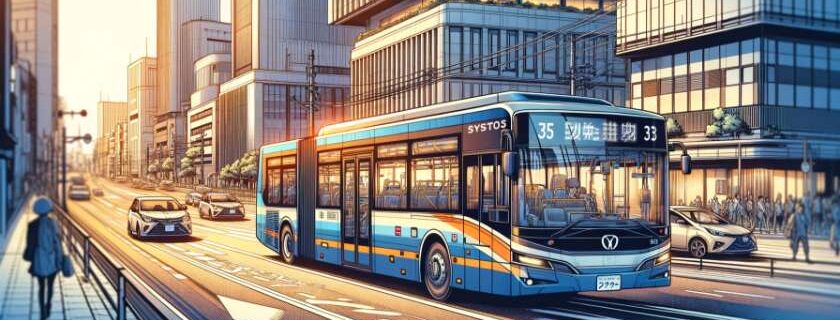
Essential Travel Checklist
When exploring Kyoto, Kyoto buses are a convenient way to navigate the city. To ensure a smooth trip, plan your itinerary ahead of time. Checking bus schedules and routes in advance can help you efficiently move around the city without wasting time waiting for buses. Don’t forget to pack essentials like comfortable shoes to walk around easily, a map to navigate through different stops, and an umbrella for unexpected weather changes.
Information centers in Kyoto play a crucial role in assisting tourists with bus routes and fares. These centers are staffed with knowledgeable individuals who can provide valuable tourist information and recommendations. If you’re unsure about which bus route to take or need guidance on planning your day’s activities, the friendly staff at these information centers will be more than happy to help you out. It’s advisable to locate these information centers strategically across key areas of Kyoto for easy access when needed.
- Information centers offer assistance with bus routes and fares
- Staff provide valuable tourist information and recommendations
- Locate information centers strategically across key areas of Kyoto
You’ve now mastered the ins and outs of navigating Kyoto’s bustling bus system. Understanding bus maps, utilizing city buses effectively, and picking up handy tips along the way have transformed you into a savvy traveler. From discount passes to recommended destinations, hotels, and alternatives to buses, you’re all set for an unforgettable Kyoto adventure. Remember your travel checklist, hop on that bus, and let Kyoto’s charm sweep you off your feet!
Explore Kyoto with confidence, armed with your newfound knowledge. Get ready to immerse yourself in the beauty of this historic city while effortlessly hopping from one destination to another. Your Kyoto journey awaits—go out there and make unforgettable memories!
Frequently Asked Questions
To navigate the Kyoto bus system effectively, study bus maps beforehand, understand routes and schedules, use smartphone apps for real-time information, and consider purchasing a day pass for unlimited rides.
When riding the Kyoto City Bus, have your fare ready in exact change or use an IC card. Board from the rear door and exit from the front. Pay attention to announcements and digital displays for upcoming stops.
Yes, there are various discount passes available, such as one-day or two-day unlimited ride passes. These can offer substantial savings if you plan on using public transportation frequently during your stay in Kyoto.
Popular destinations accessible by bus in Kyoto include Kinkaku-ji (Golden Pavilion), Fushimi Inari Taisha Shrine, Arashiyama Bamboo Grove, Gion District, Nijo Castle, and Kiyomizu-dera Temple, among others.
Apart from buses, alternative transportation options in Kyoto include taxis for convenience but at a higher cost; bicycles, which provide flexibility and exercise; and walking tours, ideal for exploring specific districts leisurely.
Recent Posts

5 Off-The-Beaten-Path Locations: Unveiling Kyoto Prefecture’s Best-Kept Secrets

10 Mystical Kyoto Temples You Need To Experience

10 Hidden Gems: Discover The Most Authentic Sake Breweries In Kyoto

10 Must-See Museums In Kyoto For Cultural Enthusiasts
Leave a comment cancel reply.
Your email address will not be published. Required fields are marked *
Save my name, email, and website in this browser for the next time I comment.
AAB Kyoto, under the guidance of its founder, has become a beacon for exploring the hidden treasures of Japan’s ancient capital. With a mission to unveil Kyoto’s best-kept secrets, the organization is dedicated to sharing lesser-known wonders and off-the-beaten-path gems with visitors and locals alike.
- Amazon Disclaimer
- Accessibility Statement
- Legal Disclaimer
- Privacy Policy
- Terms and Conditions
- Accomodation
- Food and Dining
- Transportation
- 337-1256, Daigo Sannokiri, Fushimi-ku Kyoto-shi, Kyoto
- +8116-057-9658
- [email protected]
© 2024 AABKYOTO | All Right Reserved

A single ride on the Kyoto city bus will cost you 230 yen for adults, and 120 yen for children under the age of 12. You board in the back with payments being made when you get off the bus at the front. Exact fare is always preferred, but there is a change machine available so you don’t need to worry too much.
Your rechargeable IC card (SUICA, ICOCA, PASMO, etc) will work on the bus, but if you’re taking more than 3 rides in a single day, you’re better off buying a one day Kyoto city bus pass for just 600 yen (300 yen children under the age of 12). The easiest place to buy your passes is at the “Kyoto Tourism Information Center” located inside Kyoto station, or the “bus ticket center” located outside Kyoto station (north side) where the buses depart. You can also purchase them from vending machines at major bus stops or directly from drivers on the bus, but they’re known to run out by the afternoon.
The Kyoto city bus pass is good for all buses (Kyoto tourist bus, and normal buses), but there’s an extra charge if you’re going outside the flat-fare zone. The pass does not include taking the subway. Check out the Kyoto city website for a detailed description and pictures on how to ride the bus in Kyoto.
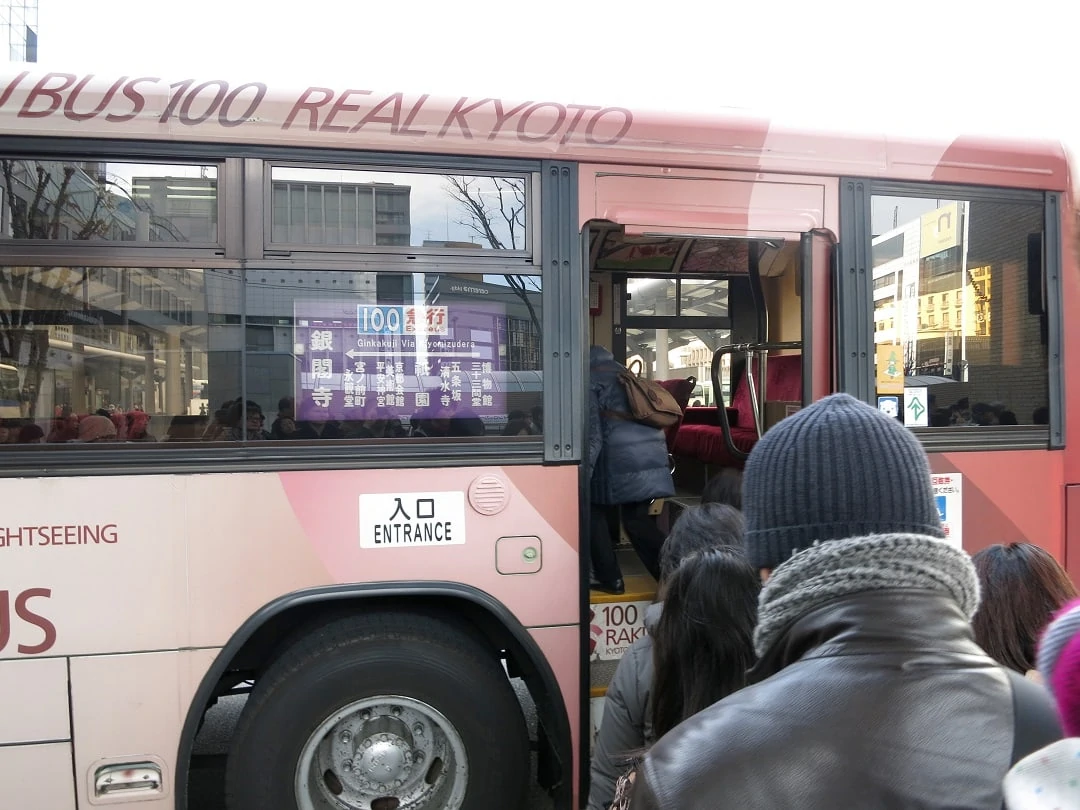
Image courtesy: Victor Lee, Flickr
When you purchase your Kyoto city bus pass, be sure to pay attention to the map that they hand you. You’ll notice that all the major tourist attractions are shown, so it’s pretty easy to figure out which Raku bus you need to take. All the attractions are announced, but there’s also English text displayed so you should know when you arrive at your destination. Remember, every bus loops. Generally speaking, you can just get on the bus on the opposite side of the street if you want to go back. See below to find out what attractions you’ll come across on each Raku bus route.
Raku bus 100 : Sanjusangendo Temple, Kiyomizu-dera Temple, Yasaka-jinja Shrine, Heian-jingu Shrine, Eikan-do Temple, Nanzenji Temple, Honen-in Temple, Ginkakuji Temple.
Raku bus 101 : Nijo Castle, Seimei-Jinja Shrine, Kitano Tenman-gu Shrine, Hirano Shrine, Kinkakuji Temple
Raku bus 102 : Ginkakuji Temple, Shokokuji Temple, Kinkakuji Temple, Daitokuji Temple.
If you look at the map below, you’ll see that the Raku bus 102 line connects with the 100 and 101 lines. Despite the fact that the map looks relatively small, it’s not realistic to do all 3 of them in a day. I would separate the Kyoto tourist bus route 100 and 101 to two separate days.
You’ll also notice that none of the buses go to the bamboo forest of Arashiyama. The easiest way to get there is to take the JR Sagano Line (also known as JR Sanin Line) to Saga-Arashiyama Station and then walk. Nijo Castle is about a 7-minute walk from the JR Sagano Line, so you could connect there if you plan to go to Arashiyama. Your JR pass will work on this line since it’s a JR line.

Image courtesy: welcome-to-kyoto.com
The Raku Bus is easily the best option for tourists since it gets you to almost every major attraction in the city. That said, buses can be slow, so taking the subway can save you some time. Taxis in Japan aren’t that expensive, so don’t be afraid to jump in one. Just show the driver the location of where you want to go on your smart phone. Another fun way to get around the city is to rent a bike. There are plenty of places to rent a bike and the city is relatively flat. Finding bike parking is the tricky part.
Not really. While your JR Pass can be used on the Takao Keihoku Line since it’s operated by the West JR Bus company, most tourists will never use this line. You can use your JR Pass for the JR Nara and Sagano lines which will get you to Nara, Fushimi Inari Taisha, and Arashiyama. The bus in Kyoto is inexpensive and reliable, so don’t focus on using just your JR Pass.
Yes, you can use any IC card in Kyoto busses which includes Suica and Passmo. However, IC cards are only good for individual rides. If you plan on using the Raku bus multiple times, you’re better off purchasing a pass. That said, if you’re not near at Raku bus line, it’s nice to know that you can jump on any bus and pay with your IC card.
It really comes down to simple math. A single adult fare is 230 yen, and 120 yen for children under the age of 12. That means if you take at least three trips in a single day, buying a pass is worth it. Three rides won’t be difficult since it’s just two stops and a return trip. Most people hop on and off the bus multiple times a day as they visit different attractions across the city.
Like many other cities in the world, Kyoto has a true hop on, hop off bus called SKY HOP BUS KYOTO . It’s arguably more convenient than the Raku Bus since it only has a single line that operates in a loop. That said, the cost is significantly higher. A same-day, 12-hour pass will cost you 2,400 yen for adults and 1,250 for children. There is a 24-hour pass available that’s good for two days and costs 3,600 yen for adults and 1,800 for children. The KY HOP BUS KYOTO is more comfortable than the Raku bus and it has two levels, so you can see the city from the second level.
Since you can’t take the Kyoto tourist bus to Nara, you’ll need to take the train. Fortunately, you can use your JR pass on the JR Nara line. The journey typically takes 70 minutes, but there are a few express trains that take only 40 minutes. Nara is the last stop on the line and just about everyone gets off there, so you can’t miss it. From there, the major Nara attractions are about a 30 minute walk. Nara also has their own tourist bus that you can use your IC card to pay for. They also have a bus pass available which can save you some money.

About Barry Choi
Barry Choi is a Toronto-based personal finance and travel expert who frequently makes media appearances. His blog Money We Have is one of Canada’s most trusted sources when it comes to money and travel. You can find him on Twitter: @barrychoi
69 Comments
Thank you so much. the informations you mentioned are very helpful especially to first timer visitor in Kyoto like me. Thank you again.

I know you’ll have a great time in Kyoto!
With the Kyoto Sightseeing Pass – is it only cover the 2 subway lines (Karasuma and Tozai line)? What about the Keihan and Hankyu line, can you use the pass?
Thanks in advance
Thank you for the information. It is very useful. Is it possible to hail the Raku bus once it has left Kyoto Station or do I have to get on at the station in order to use the service?
You can get on the Raku bus at any of its stops.
Thank you for this informative piece. I’m going with my family of 8. Would like to know is it better to do Raku bus or the Kyoto sight seeing tour as we are going to Kyoto 12 april when it’s really crowded .
It’s really a personal choice. A sightseeing tour makes things a lot easier since it requires no planning, but the odds are things will be quite rushed. The Raku bus will get you to all the main attractions and you can spend as much or as little time at each spot.
Kyoto has A LOT to see, you could easily spend 2-3 days there and not even come close to seeing all the major attractions.
What time the the Kyoto City Bus start and end their operations daily?
The Raku bus starts at roughly 8am and ends at 4:30PM
hi, my husband and I will be in Japan from Nov 12-19. we will arrive in Narita and planning to go nearby city of tokyo including Kyoto.Any recommendation for our itinerary?
It is our first time in Japan,.
Thank you in advance.
Here’s a rough itinerary for one week in Japan.
https://www.moneywehave.com/one-week-in-japan/
Thanks so much for this information. My mother and I will be in Kyoto for 6 hours before heading to an Onsen. Can you see the sites from the Raku bus or do you have to get off at each stop to see the sights? If you had to choose only one route which would you recommend?
Hi Elizabeth,
You sort of can, but not really as most of the sites are behind gates or trees. With 6 hours, I would advise picking 2-3 spots within the same area and then taking the bus or cab to get them.
E.g. Golden temple and Arashiyama or going to East Kyoto
Thanks so much for painstaking work in preparing such valuable information. It really helps the first timer visitor like me in particular. May you be well and happy always.
[…] A one day pass will cost you 500 yen (250 yen for children under the age of 12). Read my Kyoto tourist bus guide for more […]
Hi Barry, Thanks for your post. Can I use Kyoto Bus One Day pass on Raku buses? If I go to Arashiyama Bamboo Grove, how can I pay the extra fare since it is not located in the flat-fare zone?
The Raku 101 connects to the Keifuku Railway which will get you to Arashiyama (extra fare is required). That being said, most people will take a taxi from the Golden Temple to Arashiyama because it’s much quicker. Alternatively, you can take the JR line to Saga Arashiyama and then walk to the main area. I personally took the JR line since it was the quickest and I had a JR pass.
Thanks for your reply, Barry. I am actually going to visit Arashiyama Bamboo Grove area first and going to Golden Temple from there. I see Google map states Kyoto city bus can get me from Arashiyama Bamboo Grove to Golden Temple with transfer. Does this mean I can use Kyoto Bus One Day pass without extra fare? Would appreciate your help.
I believe you can use the regular bus pass on the Raku buses, but I’m going to double check and get back to you.
I am visiting Osaka/Kyoto next month but staying at Osaka all the way. I planned to travel to Kyoto on 2 days to visit the Bamboo Grove, Fushimi Inari Shrine, Kiyomizu-Dera Temple and Nara Deer Park, Tōdai-ji Temple. Any idea how to plan these? Since i am not staying at Kyoto so i try to not end too late to travel back to Osaka,
Hi Annabel,
What you want to see is kind of all over the place, so not easy to do.
This is what I would consider. Take the train directly to Nara from Namba Station in Osaka. When you get to Nara, purchase an all day bus ticket for about 500 Yen which will take you right to Todai-ji. When you’re done, the deer are literally outside the entrance to the temple. Once you’re done, take the bus back to the train station, but this time, take the JR Nara line towards Kyoto and get off by Fushimi Inari Shrine. Explore the gates and then head back to Osaka by heading to Kyoto station first.
On the second day, go to Kyoto station and then take the JR train to get to the Bamboo forest. Kiyomizu-Dera Temple is on the other side of town so you’ll have to either take a cab or train back to Kyoto station and then take the Raku bus.
Note that there is A LOT to see in Kyoto so 1 day there is likely not enough.
Thanks for taking time to provide me such detailed information. Certainly a great help for me to plan my Kyoto trip!
This is very helpful, thank you! How long does a loop on the 101 take altogether (or do you know where I can find that information)?
I don’t know how long it takes to do the entire loop, but I’m guessing 1.5 hours?
1. Is the 2 day bus-subway pass good for the Raku Bus? 2. How should I link: Kinkakuji / Arashiyama / Gion / Kyoto Handicraft Center / Nijo Castle using the bus subway pass?
I believe the 2day bus-subway pass is good for the taku bus but I’m not 100% sure.
As for your route. It depends on how much time you have. Let’s assume you only have one day. I would take the Raku 102 bus to Kinkauji. Once you’re done there, take a cab to Arashiyama. After that take the JR Sagano Line from Saga Arashiyama to Nijo station then walk to the castle. Once you’re done at the castle, go back to Nijo station (different entrance) but this time take the Tozai line to Higashiyama station and then walk to the Koto Handicraft Center. You can then walk to Gion. I personally would consider taking a cab between Nijo castle and the Handicraft center to save time. Cabs in Kyoto are not that expensive
I plan to split the Kyoto trip into 3 sessions. Day 1 from Kinkakuji to Daitokuji. Day 2 from Arashiyama, Fushimi, Kiyomizudera, Gion District and Ginkakuji (may I confirm is Ginkakuji is in Higashiyama District?). And Day 3 is Nishiki, Daigokuji and Nijo Castle. Please advise if the arrangement is good to proceed.
Kinkakuji to Daitokuji are relatively close to each other and won’t take more than an hour each. You could go to Arashiyama after and spend the rest of your day there. Alternatively, you could add Nijo to this day save Arishayma for another day
Ginkakuji, Kiyomizudera, are both in Higashiyama, Gion and Nishiki are between the two, but are better done in the afternoon / evening.
Daigoji is somewhat close to Fushimi so those two might be better done together.
I want to explore kyoto and nara in 1 day please help how to get there from namba station or nippinbashi station.is it helpful if I will buy a kansai pass? I want visit kinkakuji and ginkakuji temple,kiyomizudera,fushimira inari shrine,bamboo groove and narra park.Is it possible the we can make it in 1 day? we family of 5 the youngest is 7 yrs old.please help me the etirenary.thank you very much in advance.God bless you!!
We spoke briefly on FAcebook, but I’m answering here anyways. What you’ve currently listed is too much. You either need to drop things or spend more time in Kyoto / Nara.
I would advise choosing which site is on your MUST SEE list and then build a realistic itinerary around that.
Hello, Barry! May i ask for your advice. I will just have a quick half day visit. I am planning to visit Arashiyama Bamboo Forest early in the morning then go to Kinkakuji Temple. – from Arashiyama, is it ok to go back to Kyoto Station and take the Raku Bus 101? – will riding the bus going to Kinkuji temple cost me 230yen flat rate, then another 230yen in going back to Kyoto Station? – lastly, approximately how much time will it take to reach Kinkakuji temple from Kyoto station via Raku Bus 101? Thank you very much, in advance for your help. May you be blessed more!
Hi Michelle,
If it’s just a quick day visit I would advise taking a taxi between the two which should cost you just under 3,000 Yen. You can take the JR Sagano line to saga-arashiyama from Kyoto station and then walk to the forest. Once you’re done, take a taxi to Kinkakuji to save time. Once you’re done there, you could take the 101 bus back to Kyoto station. It takes roughly 40mins to get to Kinkakuji to Kyoto station by bus. The JR train from Kyoto station to Saga-arashiymama is about 20-25 mins and then it’s a 8-10 min walk to the forest.
Alternatively you could take the Randen tram between the two.
https://www.tripadvisor.ca/ShowTopic-g298564-i2712-k11096195-Arashiyama_Kinkaku_ji_Golden_Pavilion-Kyoto_Kyoto_Prefecture_Kinki.html
[…] Local JR Buses – Not many tourists will use local JR buses, but your pass is valid on them. The one major bus route that tourists may be interested in is the JR tourist loop bus in Hiroshima. Your JR pass is NOT valid for the Raku bus in Kyoto. […]
Two questions:
– Is there a website (hopefully in English) where I can learn if the 1 or 2 day tourist pass is valid for the Raku buses and maybe also see their schedule for each stop?
– What’s the easiest way to get from the Imperial palace gardens to the Kamishichiken Kaburenjo Theatre (for the Kitano Odori show)?
Thanks in advance for your help. I wish there was an easy to use help to provide all of this info….
The tourist pass does apply to the Raku bus since it’s considered a city bus. I believe there is a schedule somewhere online, but it’s in Japanese only. From what I recall, all the raku buses depart every 15mins so you should be good.
I’m not familiar with the Kamishichiken Kaburenjo Theatre, but according to Google Maps, it’s a 10 min drive so you’re likely better off taking a taxi for convenience. Taxis are pretty reasonable in Japan and drivers don’t expect tips (just round up)
I strongly recommend having a data plan when you’re in Japan since it’ll help you with directions.
Thanks for you help. Happy New Year!
How about this website that I just found:
https://www2.city.kyoto.lg.jp/kotsu/webguide/en/bus/rakubus.html
Yup, that’s the route of the Raku bus.
HI Barry, You are amazing with your information… Thank Yo so much for your time. My lovely and I are taking a return trip to Kyoto and we will spend only 1 night. I was thinking we would see Arashiyama, Fushimi Inari and Todaiji. Does this sound reasonable to you? We will get a JRP 7 day pass as well as using the Raku Buses.
Thank You in advance Barry for sharing your knowledge!
Kind Regards Jan from Australia
It’s doable, but things might be tricky. Todaji is in Nara, so you’re looking at a 1 hour train ride plus a 10min bus ride or 30min walk to get to Todaji. Most people go to Nara for the day. That being said, the JR Train that takes you to Nara is on the same line as Fushimi Inari.
Arashiyama is easily accessible from Kyoto station since there is a direct train to get there. You can take the JR Arashiyama line and then get off at Saga Arashiyama. It’s only a 10 min walk from the train station to the bamboo forest.
If I were you, I would drop Todaiji and spend time is eastern Kyoto – https://www.japan-guide.com/e/e2158_east.html
Fushimi Inari is open 24 hours in case you want to go at night.
Hi Barry, I have just one day to visit Kyoto next month (I’ll stay in Kobe and go for a quick visit to Kyoto). Could you recommend me a route/main spots to see having only one day? I would love hearing your proposal. thanks!
If you’ve only got a day in Kyoto, I would stick to the east side.
I would pick 3-4 spots from this guide as a starting point.
https://www.japan-guide.com/e/e3950_eastern_kyoto_full.html
I personally enjoyed Kiyomizudera, Higashiyama Streets, Heian Shrine, the Philosopher’s Path, and Ginkakuji
Thank you for the information and as a first time visitor this has been very helpful. We have a full day in Kyoto and I would like to go to the Bamboo Forest and also Kiyomizu-deta Temple while also exploring the parks and Gion area. As Bamboo Forest is on opposite sides of the city will it be difficult and too big of a day for my two children 6yrs and 7yrs? Will the traffic be gridlock if we took a taxi across town and at what cost/time?
Kind regards Tania from Australia
The Bamboo forest is on the other side of the city so getting to Kiyomizu-dera by taxi will likely cost you about 4,000 yen. That may seem expensive, but’s honestly likely worth it since it’ll save you A LOT of time since you only have one day in Kyoto. Note that you don’t tip taxis, they just keep the small change.
The forest won’t take long (an hour at max). Kiyomizu will also take about an hour but the streets around it are worth wandering so budget another hour.
Note that Gion is pretty boring during the day. That being said you can walk there from Kiyomizu and as mentioned, there will be some interesting things to see along the way. From Gion, you could go to Nishiki Market which might interest the kids?
Hi Barry, A lot of good information. Thank so much. I will visit Kyoto/Osaka and Hiroshima from April 4 through April 10 and use JR Pass to go back to Tokyo. Please help me with the itinerary for 5.5 days to see all of places plus savings on the transportation for bus, metro and subway. Appreciate very much for your advice. Tami.
with 5.5 days, I’d do 1 day in Hiroshima/Miyajima, 3 days in Kyoto (or 2 days in Kyoto and 1 day trip to Nara), One day in Osaka. The half day remaining would be best used to explore whatever city you’re departing from.
I personally favour Kyoto as a “base” especially if you stay near Kyoto station since you’ll have easy access to everything.
Hi Barry, Thanks for getting back to me promptly, appreciate very much. I’ll stay in Osaka the entire time. Please advise me with the local transportation like the Raku bus and Regional Pass in addition to my JR Pass that I have. Thanks again. It’s a big help. Tami Lam
Nothing wrong with stayin in Osaka, there’s just more to see and do in Kyoto so you’ll spend a lot of time going there for 2-3 days. Osaka is good for food and shopping so maybe that appeals to you more.
You don’t need a regional pass, just use the Raku bus in Kyoto if it fits your schedule and an IC card for all other transportation.
Just wanna confirm for those Raku busses, I dont have to board them only at Kyoto Station right. I can ride on them on any of the bus stops that the busses stop?
Ex. There is a bus stop at Nijo Castle. So can I start my bus ride from Nijo Castle and I dont have to purposely go to Kyoto Station just to board the bus.
You can get on the Raku bus and purchase a pass anywhere it stops.
We are 4 planning to visit Kyoto on 16 October. (arriving the day before) We want to visit the following places Arashiyama – visit bamboo forest Kinkaku-ji temple Fushimi Inari Taisha whisky yamazaki distillery in Kyoto Can you recommend how we should go about it.
thanks Mervyn
Are you in Kyoto for just one full day?
Arashiyama is about 30mins by train from Kyoto station. If you’re going there for just the forrest, you won’t need that much time there, but there’s A LOT of other things to see in the area. Kinkaku-ji is about a 20min taxi ride from Arashiyama and will take about an hour to see. Fushimi Inari Taisha is in the opposite direction and will take an hour by train from Kinkaku-ji or 30mins by taxi. As for the distillery, it’s outside of Kyoto and will take some time.
To be honest, you won’t have to see all 4 things so you’ll need to drop at least one thing. You also need to check if the Yamazaki distillery has set times for tours/entry (I’ve never been). You may want to consider adding another full day to Kyoto as you’re missing all the sites on the eastern side.
Hi Barry, I will be spending 3 days in Kyoto with my partner and 8 yrs old son.
I am planning the following: Day 1 Toji Temple Nijo Castle Kyoto Imperial Palace Nishiki Market
Day 2 Arashiyama Kinkaku-ji Temple Kyoto Tower
Day 3 Ginkakuji Temple Kiyomizu-dera Temple Yasaka Shrine Fushimi Inari Temple
Would like to know if the planned coverage by areas do-able?
It’s doable, there’s just a lot of travel. A few things to note. I wouldn’t go out of my way for Toji Temple, you’ll see similar things all over Tokyo. The Kyoto Imperial Palace and Nijo Castle are similar, you won’t be upset if you need to skip one. Nishiki Market is really just shops and will take you no more than an hour to go through. Nearby is pontocho and Gion but those are best seen at night.
Your day 2 is good. There are lots of things to see around Arashiyama so you could spend more time there.
Day 3 will be long, but doable. But note that Ginkakuji Temple is a ways furhter north. Nothing crazy, but you’ll need to factor in travel time.
Thank you Barry for the pointers
thanks we arriving the afternoon of 15 Oct in Kyoto spend two nights there and leave again the afternoon of 17 Oct for Tokyo
we coming from Osaka on the 15 Oct – so maybe we can fit in the distillery enroute to Kyoto ? What to you think
I’m not familiar with the distillery at all so I really can’t give you any advice there.
Hi Barry, Thank you SO MUCH for all of the amazing information! Is the Raku bus 230 yen each time you board?
It was when I was last there 4 years ago. Most people just get a bus pass for the day which was 500 Yen at the time.
Hi Barry, Thanks for all the information. I’m going to Kiyomizudera Temple from Kyoto Station, taking the Raky bus 100. For the journey back to Kyoto Station, do i assume to use the bus stop opposite of where i alighted when i arrived? Thanks!
Pretty much, but note that to get to Kiyomizudera Temple from the bus stop, it’s a little bit of a hike.
I deeply appreciate the info you provided, very useful indeed. I am going to be in Kyoto for 4 days & I have calculated to buy 4 x 1 day pass bus tickets (based on the link you provided, I could get lower 1 day pass if I have JR pass instead of 2 days pass), but by any chance you know if I could buy the pass for the whole 4 of them at once or I only could 1 day at the time?
My family shall be in kyoto for 2 nights on 26/12 and 27/12. we shall be travelling form osaka on 26th. since its winter season, can u please provide information on which place is nice to visit in Dec given the 2 days?
At this point, i am still searching on how to travel in kyoto and this raku bus seems good but does not include Fushimi Inari in its route?
To summarise, , i hope to cover Arashiyama, Gion, Fushimi, Kinkakuji and Golden pavilion but have no idea how these places are in winter, whether it closes early and what mode of transport ? appreciate your advise if i need to buy any passes for ease of travel in kyoto. Thank you
All of those sites are outdoors so not much you can do about that if you know what I mean.
From Kyoto station, Arashiyama and Fushimi are on JR lines. Kinkakuji is sort of near Arashiyama so do that on the same day (probably easiest to take a cab there) or bus to Kinkakuji first, then cab to Arashiyma. Gion is about a 15min bus ride from Kyoto station.
You’d probably need a bus pass and use your IC card or JR pass for the trains.
thank you very much Barry. will look into these passes.
[…] passes such as Kyoto where you can get to all major tourist attractions by using just the Raku bus. From time to time, you may want to take a taxi which isn’t cheap, nor do I consider them […]
Hi Barry, we have full 14 days arriving Osaka, not counting the flight in/out days from/back to Canada.
We like to do Osaka, Nara, ghibli park near Nagoya, Kyoto, Kobe and a few days driving in the kyushu island. Young family of 5. Age 10 to 15. If time allow, the island off Hiroshima or Fukuoka.
Must visit universal studio, ryankon stay, onsen, fish market, cup noodle museum, Kobe beef, Like to try as many yummy Japanese local good and sashimi as possible.
Any suggestion on itinerary and which train pass I should get? I am think Kansas pass through. Hello kitty train is still running next June/July?
My nephew in Osaka and he might be able to help us get ghibli ticket when they become open for lottery next spring.
Second time there first only in Tokyo and surrounding as kids were younger then.
Thanks so much. Wenfy
Your itinerary is very busy. It would be very rushed and tiring.
A Kansai Thru Pass won’t get you to all your locations and does NOT work on JR trains – https://www.japan-guide.com/e/e2357_005.html A JR West Pass gets you to most places you want, but not to Nagoya if you do the Ghibli Park. It can also only be bought for 7 days – https://www.japan-guide.com/e/e2361_west.html Depending on what you end up deciding on, you may need a JR Pass. I personally found Kobe beef to be a bit boring. They cook it teppanyaki and I much prefer the North American style where they grill it. Think about what are the most important things you want to do and then build a realistic itinerary.
Leave a Comment Cancel Reply
Get a FREE copy of Travel Hacking for Lazy People
Subscribe now to get your FREE eBook and learn how to travel in luxury for less

A Guide to Riding the Kyoto Buses
🚌 buses and 🚇 subway.
Kyoto ’s transportation network is much criticized as it does not actually offer comprehensive and comfortable travel solutions:
- The subway covers a limited number of destinations, as its network consists of only two lines;
- The train is mainly intended to leave the city center, and move either westward to Sagano, northward to Kurama or southward to Inari;
- Bicycle is convenient in and around Kyoto’s center. However, its use is rather uncomfortable outside those limits despite recent efforts towards creating more cycling infrastructures;
- Taxi are a convenient solution for a number of routes, but are obviously the most expensive one, and affordable only to a few travelers.
Therefore, and despite the drawbacks of this solution, buses have become the most widely used transportation for visiting the former capital of Japan (and for its elderly inhabitants whose numbers reflect the population decline). Since it is not that easy to find one’s way around with buses, we have devised a guide for traveling smoothly.
🚌 Kyoto buses : network maps, pros and cons
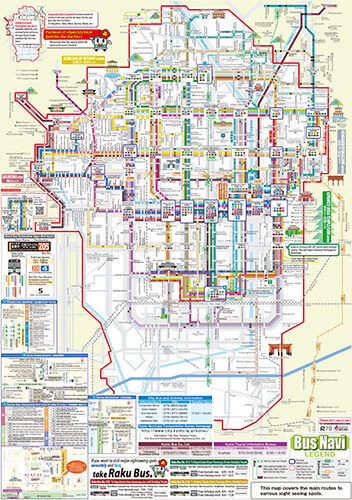
Click on the picture to display it full size.
Kyoto buses have some advantages:
- Since buses use the well-developed Kyoto street and road network , they can cover most tourist destinations;
- They run quite frequently on the most used lines;
- The number of announcements in English , especially for tourist attractions, in increasing;
- "Special" buses, numbers 202 and 205, are loop lines and numbers 100, 101 and 102 serve the most visited places;
- Municipal buses are compatible with IC cards (contactless, like the Suica card ) since 2014.
On the down side:
- One-way tickets are expensive and there is no discount for IC card holders;
- It is impossible to use the Japan Rail Pass in Kyoto buses;
- Most lines have limited schedules and service sometimes ends before 5 p. m.;
- Traffic congestion is increasing in Kyoto, causing buses to run late quite often;
- Information displays only deliver basic, undetailed information, that is not always translated;
- Buses tend to be overcrowded , especially on the main lines and/or during rush hours;
- In most cases, carrying any luggage around will prove impossible;
- As often on Japanese buses, the seat size does not fit people of taller or bigger build.
Fares and Bus passes
Kyoto Municipal buses are painted green. There are two different types which are described in detail below.
Buses serving the city only
They only serve downtown Kyoto; Arashiyama for example is not included and a different rate will apply to get there. Each line number is painted a different color. A single rate applies for all tickets regardless the number of stops or the distance covered:
- Adults: ¥230 (~US$1.56)
- Children from 6 to 12: ¥120 (~US$0.82)
The City Bus All-Day Pass is available to travel an unlimited number of trips per day. It can be bought in all buses or from automatic ticket vending machines at several stops:
- Adults: ¥700 (~US$4.76) since October 2021
- Children: ¥350 (~US$2.38)
The All-Day Pass pays off from the 4th trip on the same day. Be aware, however, that it cannot be used over a 24-hour time span. It is only valid for a day, i.e. from morning through evening. Even if you start using it in the afternoon, it will not be valid any more the next morning.
In February 2023, the scrapping of the "Bus 1-Day Pass" is announced , coming into effect on 2024, April 1rst. It is still purchasable until September 2023 for a use before 2024, March 31. Kyoto city is indeed trying to encourage sightseers to take the subway 🚇 in order to ease bus congestion. The more expensive bus + subway combined pass remains available (see fares at the end of the article).
In 2000, the pass prize was lowered from ¥700 to ¥500, which spurred the sales to one million the same year, and up to 6,14 million in 2015. In March 2018, Then, over a period of a few years, the One-Day Pass’s price rose 🌹 again to ¥600 (~US$4.08), then to ¥700 (~US$4.76) in an attempt to limit its use by tourists.
In June 2023, Kyoto’s municipal government announced seriously considering a specific fare for Kyoto residents, implying an additional charge for Japanese and international tourists. However, this policy must be legally approved by the Japanese Ministry of Land, Infrastructure, Transport and Tourism before its implementation.
Buses serving the city and the suburbs
Their distinctive feature is the line number painted on a white background. The fare is calculated according to the number of stops .
They offer another type of pass called "Kyoto Sightseeing " (half-price for children):
- 1 day: ¥1,200 (~US$8.16)
- 2 days: ¥2,000 (~US$13.60)
When you purchase this pass, you get a free map plus a range of discounts in some Kyoto stores.
Planning an itinerary
The good news for people who like to plan ahead or worry about how to find their way: there is a local version of Hyperdia, called Arukumachi , dedicated to Kyoto's transportation network.
On Arukumachi’s website, you will find information about itineraries, schedules and fares and a downloadable app for smartphone 📱 is available.
How to use the bus in Kyoto
As everywhere in Japan, people wait in line at the bus stop and carefully make sure not to block the sidewalk. Passengers board through the rear door . The procedure may then vary depending on the bus type.
Buses serving the city only:
- You do not have to buy a ticket upon boarding.
- Before your chosen stop, press one of the stop buttons to request the bus driver to stop.
- Or Purchase or show a pass.
Buses serving the city and the suburbs:
- Take a numbered ticket;
- Use your IC card;
- Punch your pass if you already have one; Or,
- Just wait to buy your pass when you get off.
- Before your chosen stop, press one of the stop buttons to request the driver to stop.
- With your IC card;
- By showing your pass;
- By purchasing a pass.
Just like in most buses around the world, the name of the next stop is displayed on a screen in the front part of the vehicle, often spelled out in Japanese and sometimes translated into English.
The machine by the driver’s seat
Located on the left of the driver (who sits on the right-hand front of the vehicle), this machine is intended to handle most passenger-related procedures.
It may be used, among other things, to:
- Get change for ¥1,000 notes (~US$6.80), ideally before you reach your stop so as to avoid blocking traffic;
- Collect your payment through a tiny slot with the exact amount (no change given);
- Pay directly with your IC card, from which the amount will be deducted;
- Punch your pass when using it for the first time (you will only be required to show it to the driver after that).
The simplest way is obviously to use an IC card. If you forgot your Tokyo Suica card for example, it is worth purchasing an Icoca or Pitapa card (the local cards in Kansai ).
Additional advices
Kyoto buses being cramped and overcrowded, it is almost impossible to carry any (especially bulky) luggage around when riding them. Therefore, we strongly recommend the use of the excellent Takkyubin delivery system or simply to hire a taxi if you don’t travel light.
Lastly, all the bus stops in Kyoto city provide free Wifi 📶 (although not on the buses). You just need to connect to the "KYOTO WI-FI" network and agree to the terms of use from the page displayed in your browser. Sessions are 30 minutes long. This service is available from 5 a. m. to 1 a.m.
🚇 The subway : A possible alternative
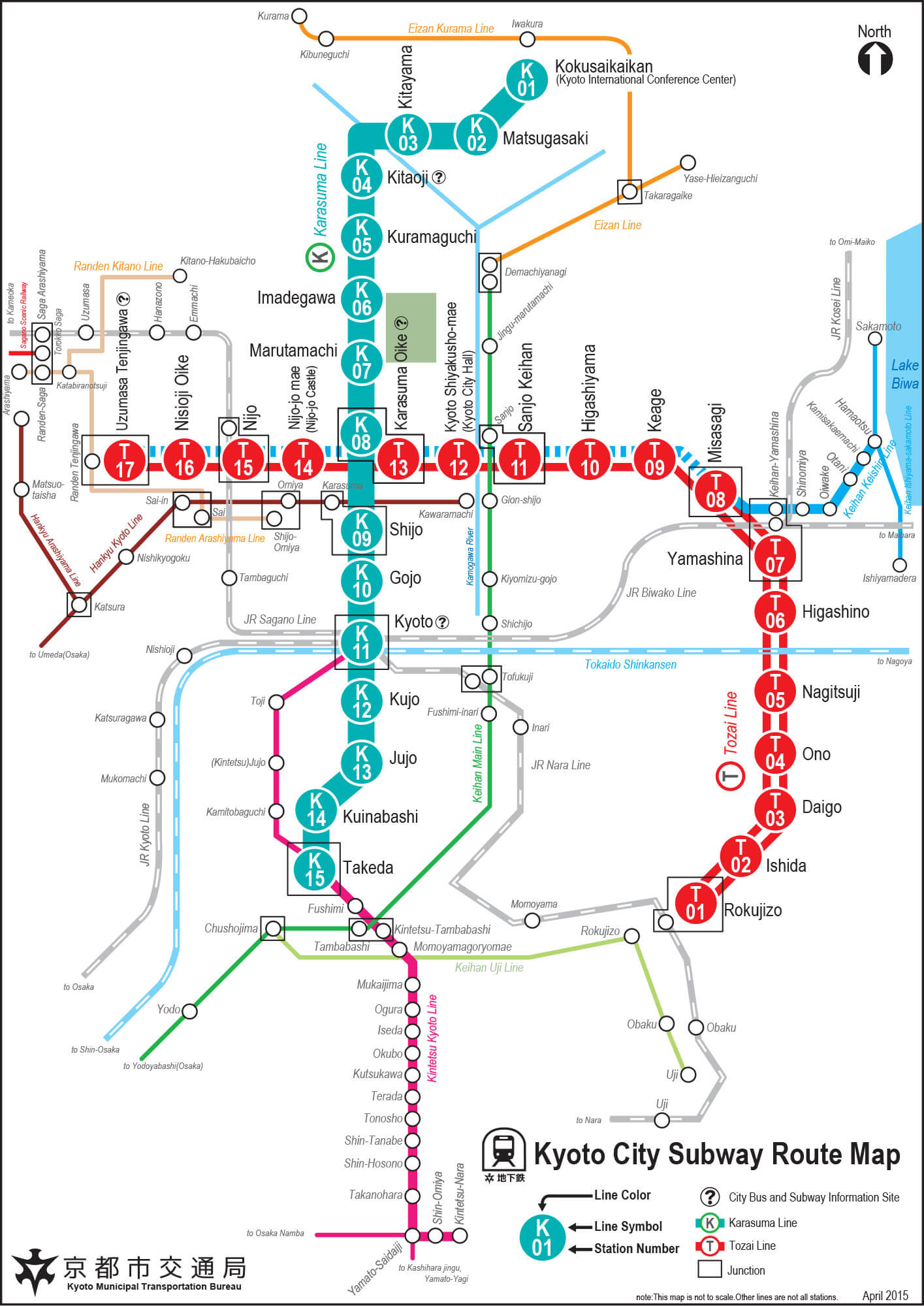
Depending on your destination, it may sometimes prove more convenient to ride the subway. However, although less crowded and free from traffic congestion, it has two main drawbacks. First, its network consists of only two lines:
- Karasuma / K (Turquoise and vertical) north bound to the Kyoto International Conference Center at Kokusaikaikan and south to Takeda, via the Kyoto JR station.
- Tozai / T (red and horizontal, or nearly…), west bound to Uzumasa Tenjingawa and south-east to Rokujizo.
They cross paths at Karasuma Oike in Kyoto’s center.
The second drawback is the price: it is the most expensive subway in Japan, and it nonetheless fails to cover its abysmal losses (8.6 billion Yens in 2010 despite efforts to attract customers). You can pay with your IC card or buy a ticket; fare is calculated according to the distance:
- Adults: from ¥220 (~US$1.50) to ¥360 (~US$2.45)
- Children: from ¥110 (~US$0.75) to ¥180 ((~US$1.22)
The JR Pass is not compatible with the Kyoto subway either which, however, offers an unlimited travel one-day pass:
- Adults: ¥800 (~US$5.44)
- Children: Half price
A combined Pass bus + subway is also available:
- Adults (1 day): ¥1,100 (~US$7.48)
- Children: Half the price
It is worth mentioning that the Arukumachi app also includes Kyoto subway. Please visit this address to download it.
- Flights and Airports
- Accommodation
- Transportation
- Internet & Phones
- Budget and money
- Japanese Food
- Visit with Kids
- Seasons: spring / summer / autumn / winter
- Weather forecast
- Time in Japan
- Holidays & Festivals
- Natural Disasters
- Customs and Duties
- Works and Closures
- From April 14 to 15 -- Sanno Matsuri (the Spring Takayama Festival)
- From April 29 to 5 May -- Japanese Golden Week
- May 12 -- Mother's Day in Japan
- June 6 -- Beginning of the rainy season (Tsuyu) in Japan
- June 21 -- Summer starts in Japan
- From July 1 to 31 -- Gion Matsuri Festival in Kyoto with float processions on July 17 and 24
- Tokyo : Shinjuku , Shibuya , Harajuku , Asakusa , Akihabara , Odaiba , Ikebukuro , Ueno , Roppongi , Chiyoda , Ryogoku ...
- Around Tokyo: Kamakura , Nikko , Hakone , Mount Fuji , Mount Takao , Yokohama ...
- Kansai: Kyoto , Nara , Osaka , Mount Koya , Himeji , Kobe , Kinosaki , Kumano Kodo , Ise ...
- Japanese Alps: Kanazawa , Matsumoto , Takayama , Shirakawa-go , Nakasendo ...
- West: Hiroshima , Miyajima , Shikoku , Onomichi , Naoshima , Izumo , Kurashiki , Matsue ...
- South: Kyushu , Okinawa , Yakushima ...
- North: Hokkaido , Tohoku ...

- Temples and Shrines
- Gardens and Parks
- Hiking and Trekking
- Observation Decks
- Public Baths (Onsen and Sento)
- Festivals (Matsuri)
- Amusement Parks
- Visit on a Budget / Luxury

Keikaku is a travel agency specialist of Japan and providing different kind of services:
- Japan Rail Pass
- English speaking Guides
- Pocket Wi-fi
- Japan Nightlife
- Working in Japan
- Religion and Spirituality
- Arts and History
- Movies / Animated Movies
- Japanese Music
- Studio Ghibli
- Photos / Videos
- Weird Japan
- Translations
- Kana & Kanji
- Japanese Swear Words
- Honorific Suffixes (san, kun, chan...)
- Introducing yourself
- Thank you / Apologize
- Count / Say Your Age
- Say the Date / Tell the Time
- Happy birthday
- Enjoy Your Meal
- Writing your name

Kanas are the much-needed basic characters of written Japanese language. Memorize them at a fast pace with our method.

Ask any kind of question and share your knowledge about Japan in Kanpai’s community space, our Q&A section Kotaete.

Isshoni means "together" in Japanese: share your trip details (dates, places you would like to visit) and find companions to travel in Japan.

Create your Kanpai account to manage your profile and view your participation history (questions, answers).
Kyoto Bus & Subway Travel Cards & Passes 京都市営地下鉄
- Published on : 13/02/2022
- by : Japan Experience
- Add to favorites
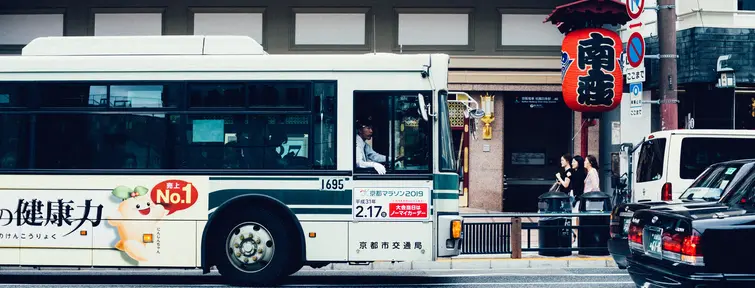
Bus in Kyoto
©Andrew Leu, Unsplash
The city of Kyoto is a center of traditional culture in Japan that is one of the country's most popular destinations. Take a look at how to navigate throughout the city and some of the transportation options that are available.
Kyoto Bus & Subway Fares
Single fares for adults on Kyoto's subway system range from and 220-350 yen for adults and 110-180 yen for minors. Kyoto's subway system has two lines: the north-south Karasuma Line (green) and the east-west Tōzai Line (red).
Kyoto City Buses have a single fare of 230 yen for adults and 120 yen for children within the designated central area. As you travel outside the designated area the fare increases. Pick up a numbered ticket on entry. The fare corresponding with your number is shown on an electronic signboard at the front of the bus.
Kyoto City Subway One-Day Pass
The Kyoto City Subway One-Day Pass allows unlimited travel on Kyoto's subway and costs 800 yen for adults and 400 yen for children.
The Kyoto City Subway One-Day Pass includes discounts on admission to Kyoto Municipal Museum of Art, Nijo Castle, Kyoto Zoo, The Museum of Kyoto and Kyoto International Manga Museum.
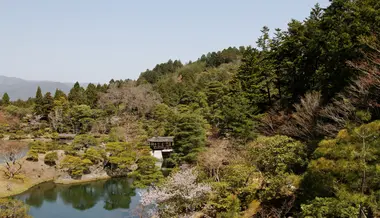
Shugakuin, accessible via train or bus in Kyoto
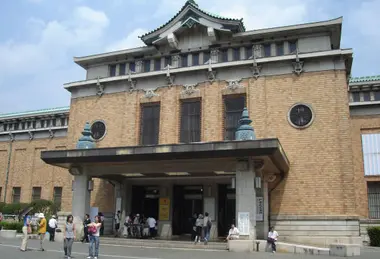
Kyoto KYOCERA Municipal Art Museum , accessible via train or bus in Kyoto
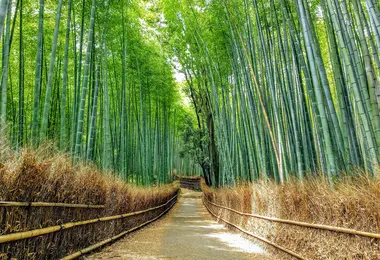
Arashiyama Sagano Bamboo Forest, accessible via bus or train in Kyoto
Kyoto City Bus One-Day Pass
The Kyoto City Bus One-Day Pass allows for unlimited travel on all Kyoto city buses and Kyoto buses within the downtown fixed rate zone (including Arashiyama and Shūgakuin ) and costs 700 yen for adults and 350 yen for children.
The Kyoto City Bus One-Day Pass is available from the Kyoto Station Tourist Information Center, subway station ticket windows, any Kyoto bus and Kyoto City Bus Offices.
Subway, Bus One-Day & Two-Day Passes
These passes are valid for the Kyoto subway, Kyoto city buses , Kyoto buses and certain Keihan buses (namely to Yamashina and Daigo). Unlike the Kyoto City Bus One-Day Pass (see below), the One and Two-Day Subway, Bus Passes include travel to Saihō Temple (Kokedera; Moss Temple), Ōhara and Iwakura .
The Subway, Bus One-Day Pass is valid only for the day it is issued (not 24 hours) and costs 1,100 yen for adults and 550 yen for children.
The Subway, Bus Two-Day Pass is valid for two consecutive days and costs 2,000 yen for adults and 1,000 yen for children.
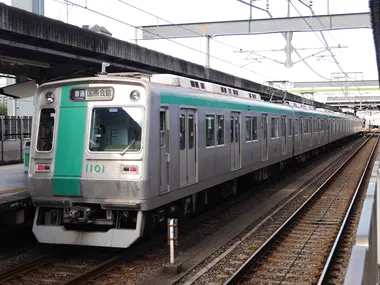
Kyoto Subway rideable with the Subway, Bus Pass
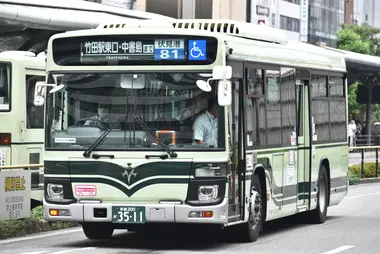
Kyoto Bus rideable with the Subway, Bus Pass
K'Loop Buses
K'Loop Buses operate on weekends and public holidays and travel in a clockwise loop connecting many of Kyoto's attractions and UNESCO World Heritage Sites.
K'Loop Bus Stops
Kyoto Station Hachijoguchi | Shijo Kawaramachi and Nishiki Market | Kyoto City Hall/Honnoji Temple |
Nijo Castle | Kyoto Imperial Palace (Gosho) | Kitano Tenmangu/Kamishichiken | Kinkakuji Temple |
Daitokuji Temple | Botanical Gardens | Shimogamo Shrine/Tadasu-no-mori | Demachiyanagi | Ginkakuji |
Temple Heian Jingu/Okazaki Museum area | Chion-in Temple and Maruyama Park | Gion and Yasuka Shrine |
Kiyomizudera | Sanjusangendo/Kyoto National Museum
The fare is 1,500 yen (700 yen for children) for a day pass allowing you to hop on and hop off at any stop. Buy the ticket on the bus from the driver.
JR-West Kansai Area Pass and Kansai Wide Area Pass
Although not valid on Kansai's subways, the J R-West Kansai Area Pass can be used on JR trains connecting Kyoto , Osaka , Nara , Kobe , Nishi-Akashi and Himeji as well as the Haruka Express from Kansai International Airport (KIX) .
The pass can be bought for 1-day , two successive days , three successive days and four successive days - with half price for children (age 12 or under). The JR-West Kansai Area Pass is available from major stations in the Kansai.
The pass is not valid on Shinkansen trains.
Icoca and Kansai One Pass
Icoca is issued by JR West in the Osaka metropolitan region, Kyoto, Kobe, Okayama , and Hiroshima . Pasmo and Suica Cards that are distributed in Tokyo are also usable in Icoca .
The Kansai One Pass is a special Icoca, also for foreign passport holders only, that has the bonus of special deals and discounts at numerous sightseeing spots and tourist attractions throughout the Kansai area.
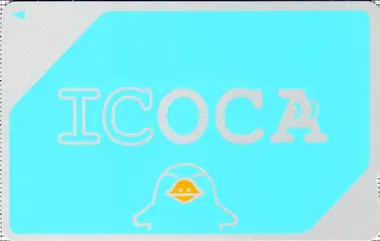
Kansai One Pass card
Showing a non-Japanese passport entitles the purchaser of an Icoca card to a substantial fare discount for the Haruka express train serving Kansai International Airport, in a package called Icoca & Haruka .
Operating Hours of Kyoto Buses & Subway
Kyoto's subway runs from around 5.30 am until 11.55 pm, 7 days a week with reduced services at the weekends and public holidays .
Tunneling was slow during the construction of the two lines to allow time for archaeological research on Kyoto's long history. Items of interest found during the construction are displayed at Karasuma Oike Station .

Kyoto Metro Map
More Travel Tips
- How to use IC cards in Japan
- Getting around Kyoto
- Buses in Kyoto
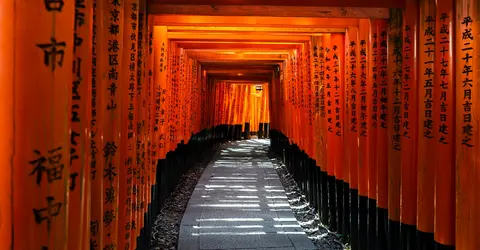
KANSAI Area Pass Regional Japan Rail Passes
- Included : Economic and simple, Unlimited travel
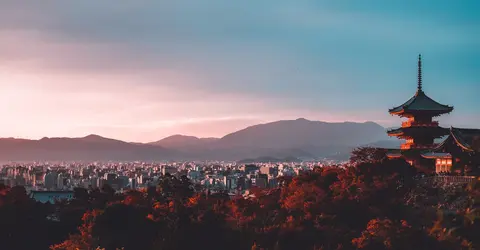
KANSAI WIDE Area Pass Regional Japan Rail Passes
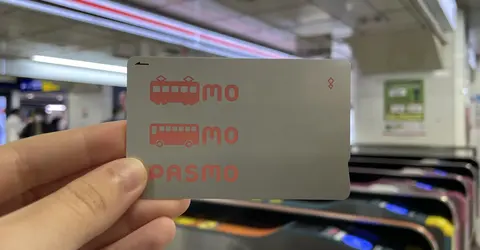
Pasmo Pre-paid transport pass Prepaid Cards
- Included : Pre-charged and ready to use, Can be used as an electronic wallet, Valid in Tokyo and other major cities
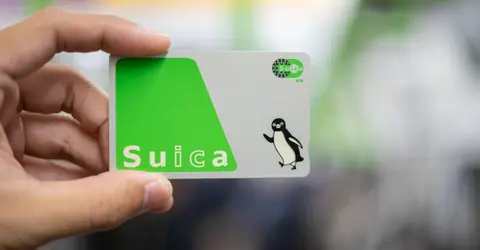
Suica Pre-paid Transport pass Prepaid Cards
- Included : Can be used as an electronic wallet, Pre-charged and ready to use, Valid in Tokyo and other major cities
Our houses in Kyoto
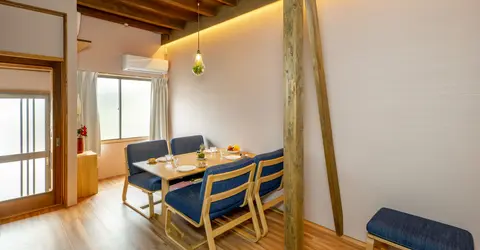
Kizuna Rent a house in Kyoto
Nijo Castle, Kyoto
- 4 travelers

Demachi Rent a house in Kyoto
Demachiyanagi, Kyoto
- 3 travelers
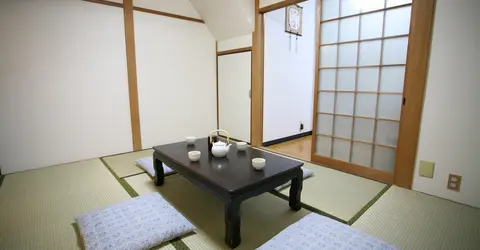
Demachi 2 Rent a house in Kyoto
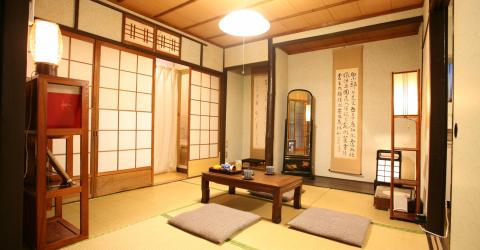
Gion Rent a house in Kyoto
Gion, Kyoto

Gion Matsubara Rent a house in Kyoto
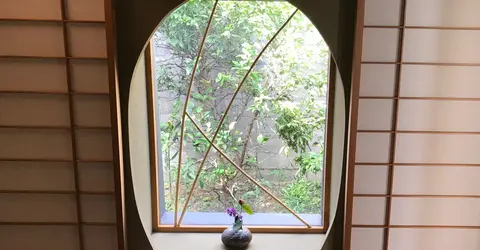
Poem Box Rent a house in Kyoto
- 2 travelers
Our activities in Kyoto
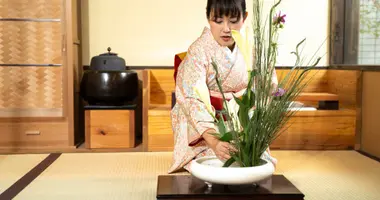
Ikebana, the art of flower arrangement Activities in Kyoto
- Duration : 1 hour
- Location : Kyoto

Shodo, Japanese calligraphy Activities in Kyoto

Fushimi Inari, the mountain sanctuary Activities in Kyoto
- Duration : 3 hour

Shiatsu Massage Activities in Kyoto
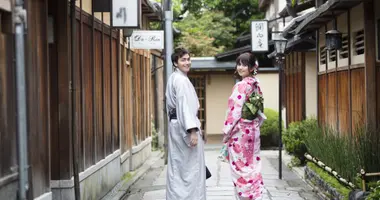
Kimono rental in Kyoto Activities in Kyoto
- Duration : 6 hour
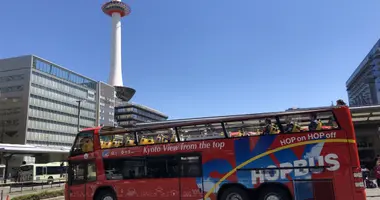
Sky Hop Bus Kyoto Activities in Kyoto
- Duration : 9 hour
Our tours in Kyoto
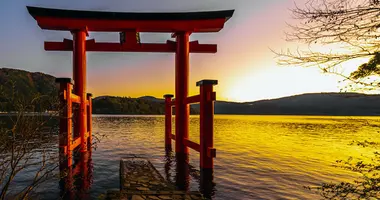
Discover Japan Group Tours in Japan
- Duration : 13 days
- Locations : Tokyo, Hakone Mt Fuji, Kyoto, Nara, Hiroshima, Miyajima
- Included : Visits & meals, English-speaking tour leader, Hotel temple, 3*/4* Hotels & Ryokan
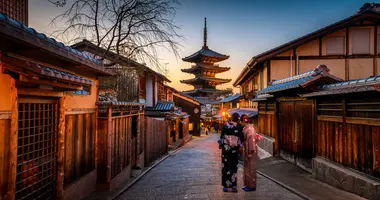
The Tokaido Road Group Tours in Japan
- Duration : 14 days
- Locations : Tokyo, Hakone Mt Fuji, Kyoto, Nara, Koyasan, Osaka
- Included : English-speaking tour leader, 3*/4* Hotels & Ryokan, Hotel temple, Visits & meals
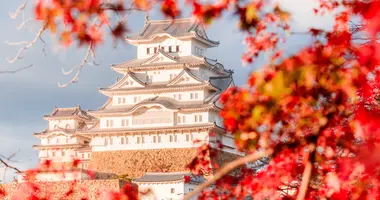
Autumn Leaves Photography Group Tours in Japan
- Duration : 12 days
- Locations : Tokyo, Mt Fuji (Kawaguchiko), Osaka, Himeji, Kyoto, Nara
- Included : English-speaking tour leader, 3* Hotels & Ryokan, Visits & meals
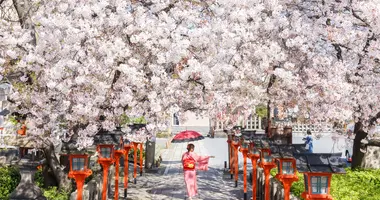
Cherry Blossoms Photography Group Tours in Japan
- Locations : Tokyo, Kyoto, Osaka, Nara, Kawaguchiko, Tokyo
- Included : English-speaking tour leader, 3*/4* Hotels & Ryokan, Visits & meals
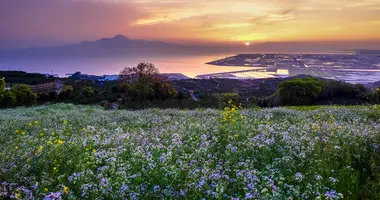
Urban and Rural Japan Group Tours in Japan
- Duration : 21 days
- Locations : Tokyo, Hakone Mt Fuji, Kyoto, Nara, Koyasan, Osaka, Kobe, Takachiho, Kumamoto, Nagasaki, Hiroshima, Miyajima
All the themes of the city
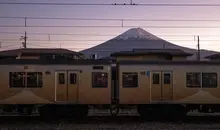
Unique Trains in Japan
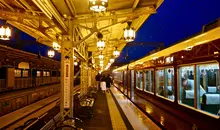
Japanese Stations
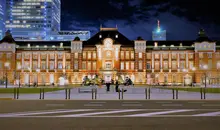
Getting Around Tokyo
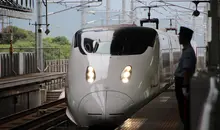
Shinkansen Travel Tips

Itineraries for Japan
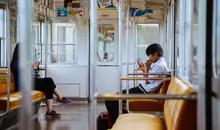
Trains in Japan
Please select your country on the list below:
- Switzerland
- United Kingdom
- Other countries
KYOTO Sightseeing "OKOSHI" Bus

The name "Okoshi" is derived from the Japanese phrase which means "Thank you for coming from afar." KYOTO Sightseeing "OKOSHI" Bus and Kyoto Sky Bus that tour the main tourist spots in Kyoto are recommended for those who want to tour around Kyoto without the hassle of transferring between buses or trains.
The on-board multi-lingual audio guide in English, Chinese and Korean can provide description of the attactions on the way.

Advantages of Kyoto Sightseeing Bus
- No bus or train transfers necessary.
- Sightseeing entrance fees included. No extra payment.
- The multi-lingual audio guide in English, Chinese, and Korean. *The multi-lingual audio guide is not available for some courses.

Kyoto SKY BUS
Advantages of Kyoto SKY BUS
- Opentop bus view
- Easy sightseeing
- The multi-lingual audio guide in English, Chinese, and Korean.
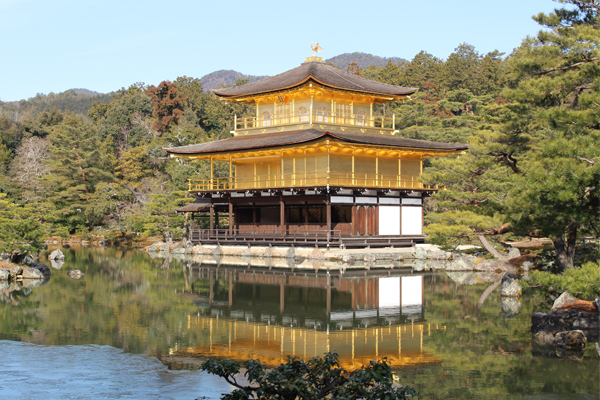
Classic Kyoto
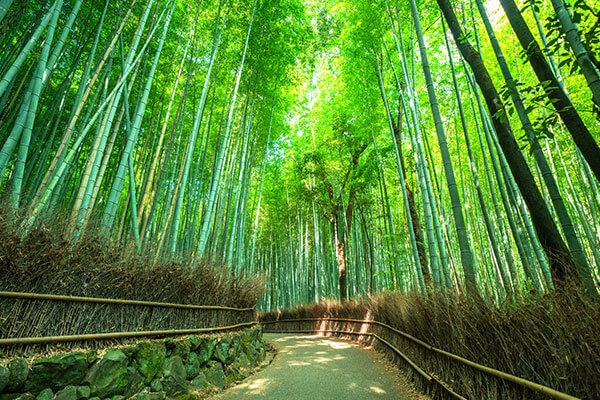
Kyoto Highlights - Arashiyama, Kingakuji, and Fushimi Inari
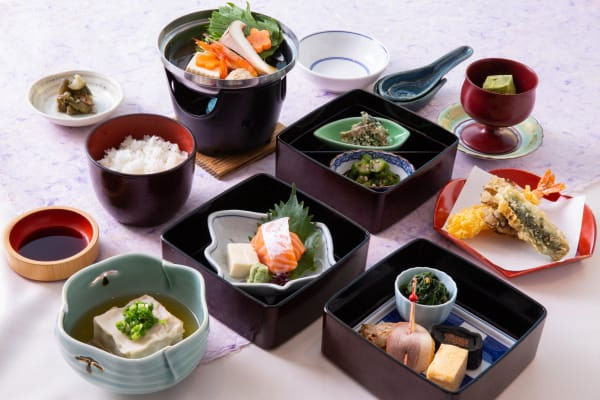
Maiko Dance & Kyoto Night View
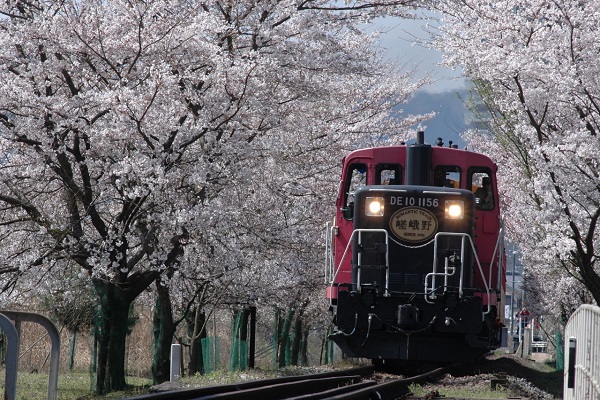
One Day in Arashiyama
*The image is a photograph taken during the spring season.
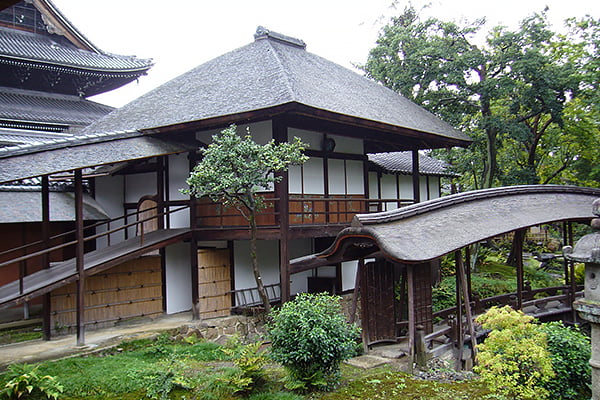
Kyoto's Three Pavilions and Gardens
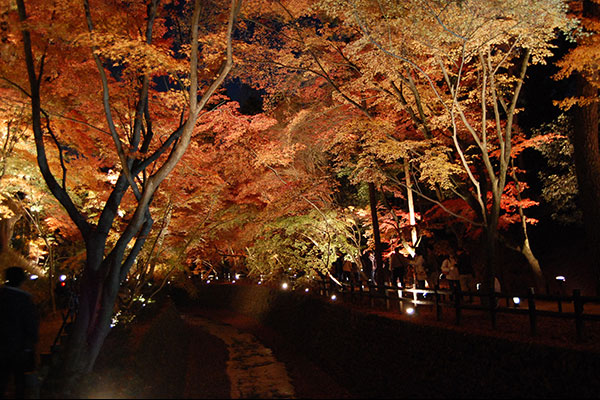
Maiko Dance & Autumn Illumination

Kyoto Half Day Sightseeing - Sanjusangendo and Fushimi Inari Taisha Shrine
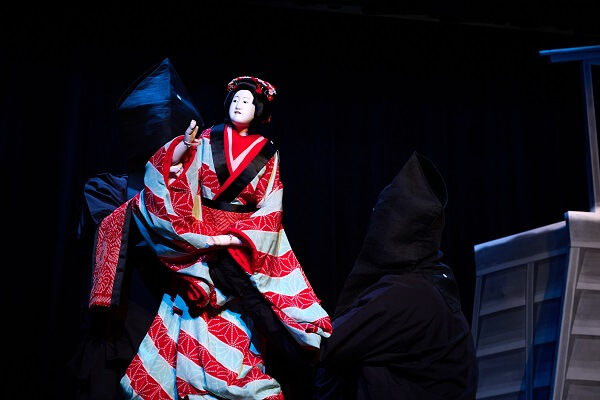
Japanese traditional performing arts and Kyoto specialty "Imobo"
*The multi-lingual audio guide is not available in this course.

Kyoto Sky Bus
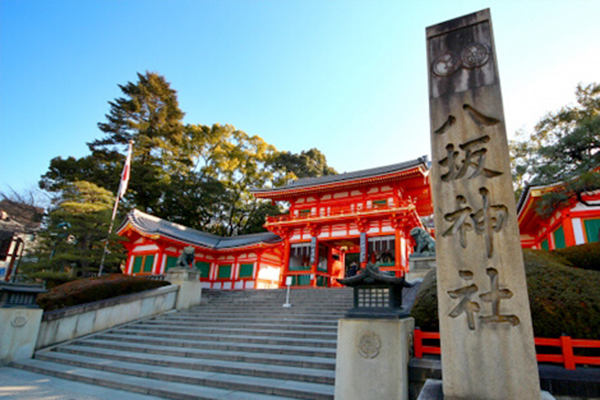
On Board Sightseeing SKY BUS Kyoto Drive Around Tour
- --> This tour is equipped with the multi-lingual audio guide in English, Chinese, and Korean. The system may not be available due to maintenance.
- The order of sightseeing spots are not the same as above. Itineraries and times are subject to change due to weather and traffic.
- The tour guide can only speak in Japanese.
- The photos are for illustrative purposes only. Actual sightseeing spots or dishes may vary.
- Online reservations only.
Discover Kyoto & Nara Tours | Sightseeing & Experience in Kyoto

Sagano Romantic Train For Spring in Arashiyama Bus Tour

Kyoto Gion Festival and Lake Biwa Lunch Cruise Tour

Kyoto and Nara Golden Route 1 Day Bus Tour

Hidden Scenic Sakura Spot in Nara Tour

Kyoto Golden Route Day Trip Bus Tour

Nara Half Day Golden Route Bus Tour

Kyoto Gion Twilight Walking Tour with Kimono Experience

Discover Kyoto & Nara Tours
Kyoto is a city of beauty and history. It is the former capital of Japan, and it is home to many UNESCO World Heritage Sites, including Kiyomizu-dera Temple, Kinkaku-ji Temple, and Arashiyama Bamboo Grove. Kyoto is also known for its Maiko, traditional Japanese tea ceremonies, and its delicious food. One of the best things about Kyoto is its abundance of temples and shrines. There are over 2,000 temples and shrines in Kyoto, and each one is unique and beautiful. Some of the most popular temples and shrines include Kiyomizu-dera Temple, Kinkaku-ji Temple, and Fushimi Inari-taisha Shrine. If you are looking for a city that is both beautiful and historic, Kyoto is the perfect place for you. With its abundance of temples, shrines, and natural attractions, Kyoto is sure to amaze and enchant you.

Kyoto & Nara Sakura Tour

Kyoto & Nara Winter Tour

Discover Kyoto

Discover Arashiyama

Discover Nara

Kyoto Culture Experience
Recommended kyoto & nara tour.

- Visit famous Todai ji Temple and Kinkakuji temple.
- Visit a huge beautiful garden of Kyoto imperial palace.
- Bamboo grove in Arashiyama is beautiful place to walk.
- Travel with comfortable air conditioned bus.
Standard Plan
- Adult(age 12+) : 17,500JPY
- Child(3-11) : 15,500JPY
Kyoto & Nara Seasonal Tour

Kyoto Gion Festival and Lake Biwa Lunch Cruise Bus Tour
Let’s join one of the most famous festival in Japan "Gion Matsuri festival" and enjoy Lake Biwa Cruise with lunch buffet!
- From 12,000 JPY

Let's enjoy a beautiful silver world and light up at night in Snow Lantern Festival in Miyama, Kyoto!
- From 17,000 JPY

Kyoto's World Heritage Cherry Blossom Walking Tour
Kyoto's World Heritage & Cherry Blossom Tour! Explore Ninna-ji Temple, Ryoan-ji Temple, Nijo Castle, and Hirano Shrine with the beautiful cherry blossoms in Kyoto.

Kyoto Sightseeing Tour

If you have only one day in Kyoto and want to see many recommended spots of Kyoto, this tour is the best for you!
- From 17,500 JPY

Enjoy Kyoto Full Day Walking Tour
Experience the essence of spring in Kyoto with the ultimate lineup: "Randen Sakura Tunnel," "Arashiyama," "Kodai-ji Temple Illumination,".
- From 9,000 JPY

Arashiyama is located in the northwestern area of Kyoto and one of the popular tourist destinations in Japan. A lot of visitors for its world renowned bamboo grove and beautiful scenery that changes with each season. Especially during the cherry blossom and fall color seasons are best.
Arashiyama Sightseeing Tour

Let's have a special spring experience taking Sagano Romantic Train and Hozugawakudari River Boat Ride!

Enjoy best places to visit in Kyoto and Nara in a one day! Todaiji temple Greta Buddha, Nara deer park, Arashiyama and some more.

Yakata-bune of Arashiyama
You can rent a houseboat in Arashiyama and enjoy your meal while watching the seasonal scenery of Arashikyo.
- From 5,300 JPY

Nara is a tourist destination close to Kyoto and Osaka, and was once the capital of Japan. It has a history older than that of Kyoto, and the entire city retains a traditional landscape. The main attractions are the World Heritage-listed Shinto shrines and Buddhist statues, making Nara one of the best tourist cities in Japan.
Nara Sightseeing Tour

Visit Hidden Scenic Sakura Spot in Nara 1 Day Bus Tour
Experience the breathtaking spring scenery with cherry blossoms in Nara's hidden gem, "Takami no Sato," featuring 1000 weeping cherry trees!
- From 11,900 JPY

Uncover Nara's history at Todaiji Temple and Kasuga Taisha Shrine, and meet friendly deer at Nara Park on this half-day tour from Kyoto.
- From 8,000 JPY

Yoshino Senbon Zakura Cherry Blossom 1 Day Bus Tour
Yoshino Senbonzakura a famous cherry blossom spot in Japan, and the "Asuka Ruby" brand strawberries, which are like gems, are available for all-you-can-eat strawberry picking!
- From 10,500 JPY
Discover Fushimi Inari

Fushimi Inari Shrine is one of the most popular tourist destinations in Kyoto, Japan. It is famous for its thousands of vermilion torii gates, which line a path that winds up a mountain. The shrine is dedicated to Inari, the Shinto god of rice, and is a popular place to pray for good fortune.
Fushimi Inari Sightseeing Tour

Kyoto Golden Route Day Trip Bus
Let's visit 6 unmissable sightseeing spots which are famous Fushimi Inari shrine, Kinkakuji temple, Arashiyama and some more in Kyoto!
- From 16,000 JPY

Kyoto Walking Tour: Fushimi Inari Taisha Shrine and Sake Tasting
Visit the Sake Museum in Fushimi and taste some samples of Japan's finest sake!
- From 9,500 JPY

Enjoy Kyoto Full Day Walking Tour from Kyoto
Visit a unique and unforgettable experience.of Fushimi Inari, Kiyomizudera, the Kyoto Imperial Palace, the Golden Palace, and Arashiyama.
- From 8,980 JPY
Discover Kyoto Culture Experience

Deep Experiencing various Japanese culture is one of the things to do on your trip to Kyoto. Here are some special cultural experiences unique to Kyoto, an ancient capital with a thousand-year history.
Kyoto Culture Experience Tour

Let's explore the traditional atmosphere of Gion district in Kimono at twilight time!
- From 11,000 JPY

Kyoto Kimono Rental Experience and Maiko Dinner Show
Immerse in Kyoto's culture with kimono, local food, Gion walk, Kaiseki dinner, private Maiko chat, dance, games, and photo. All welcome!
- From 45,000 JPY
Inside Kyoto
A Kyoto Travel Guide
Kyoto Buses
Kyoto buses are a useful way of getting around the city. Download an online Kyoto bus map for free to help you plan your journey.

The Takeaway:
- See the Kyoto Transport Overview for a general summary of Kyoto transport.
- Unless you’ve got a rental bicycle, buses are the best way to get to destinations not served by subway or train lines.
- Take the train or subway instead of the bus whenever possible. Trains and subways are faster and more comfortable than buses.
- Take the bus to the northwest of town (Kinkaku-ji Temple, Ryoan-ji Temple, Myoshin-ji Temple etc).
- Take the bus to the northeast of town (Ginkaku-ji Temple, Honen-in Temple, Manshu-in Temple, Shisen-do Temple, Shugaku-in Temple).
- If you have a group of three or four people, consider taking a taxi instead of a bus for short journeys. The price is about the same and you’ll get there faster and in more comfort.
- If you plan to use the bus a lot, you should probably buy yourself a bus pass. For more details, see our Special Kyoto Bus, Train and Subway passes page
- Arm yourself with an English-language bus map. The map is called: Bus Navi: Kyoto City Bus Sightseeing Map. Pick up a hardcopy version of this map at the Kyoto Bus Information Center, just outside Kyoto Station.
Download an English-Language Kyoto City Bus Map:
- Simplified version (PDF)
How To Use The Kyoto City Bus
- Enter at the rear of the bus.
- Use coins to pay your fare into the box at the front next to the driver. The machine next to the driver will change Y500 coins and Y1000 notes.
- Exit at the front of the bus.
- When you want to get off, press the button next to your seat, on the poles or on the ceiling of the bus (you’ll known them when you see them).
- There is a flat fare for buses in the city center: Y220/110 for adults/children aged 6 to 12. Children under 6 ride for free.
- For destinations outside the city center, take a seiriken (a small numbered paper ticket) from the machine near the door where you board. Use the number of the ticket to calculate the fare when you get off. Put the ticket into the fare box along with your fare.
- Some bus stops have signs that indicate when buses are approaching the stop. All bus stops have bus timetables written in Japanese with English route numbers (so you can read them even if you don’t speak Japanese). The schedules list times for weekdays ( 平日 ), Saturdays ( 土曜日 ), and Sundays/holidays ( 日曜日 / 祝祭日).
- Three-digit bus numbers on a red background indicate loop lines. Two digit numbers on a blue background are usually north-south lines.
- Take care when you board buses: Kyoto city buses are green; Keihan buses are red and white; Kyoto buses (which serve point north of the city) are tan.
Chris Rowthorn’s Kyoto Bus Tip
Kyoto city bus #5 is almost always crowded with residents and tourists. If you’re going to the northern Higashiyama area, take the subway from Kyoto Station.
Take the Karasuma Subway Line to Karasuma-Oike Station, switch to the Tozai Subway Line and get off at Higashiyama (for the museum district) or Keage (for Nanzen-ji Temple and the Path of Philosophy/Ginkaku-ji Temple.
You can also take the Keihan Line to Demachiyanagi Station and walk to Ginkaku-ji in about 15 minutes (follow Imadegawa-dori east to the mountains).
Check Hotel Availability
Destination, check-in date, check-out date.

Kyoto Vacation Checklist
- For all the essentials in a brief overview, see my First Time In Kyoto guide
- Check Kyoto accommodation availability on Booking.com and Agoda.com - often you can book with no upfront payment and free cancellation
- You can buy shinkansen (bullet train) tickets online from Klook - popular routes include Tokyo to Kyoto , Kyoto to Osaka and Kyoto to Tokyo
- Need tips on where to stay? See my one page guide Where To Stay In Kyoto
- See my comprehensive Packing List For Japan
- Buy a data-only SIM card online for collection when you arrive at Kansai International Airport (for Osaka and Kyoto) or Tokyo's Narita Airport . Or rent an unlimited data pocket wifi router
- Compare Japan flight prices and timings to find the best deals
- If you're making frequent train journeys during your visit, you might save money with Japan Rail Pass – see if it's worth it for you
- A prepaid Suica card makes travelling around Kyoto easy – here's how
- World Nomads offers simple and flexible travel insurance. Buy at home or while traveling and claim online from anywhere in the world
Kyoto District Map

- Central Kyoto
- Northwest Kyoto
- Northern Higashiyama
- Southern Higashiyama
- Downtown Kyoto
- Kyoto Station Area
- South East Kyoto
Disclosure: InsideKyoto.com is a participant in the Amazon Services LLC Associates Program, an affiliate advertising program designed to provide a means for sites to earn advertising fees by advertising and linking to amazon.com and amazon.co.uk. World Nomads provides travel insurance for travellers in over 100 countries. As an affiliate, we receive a fee when you get a quote from World Nomads using this link. We do not represent World Nomads. This is information only and not a recommendation to buy travel insurance.
SoraNews24 -Japan News-
Bringing you yesterday's news from Japan and Asia, today.
RocketNews24 Japanese
- TOP » Japan
- » Kyoto creates new for-tourist buses to address overtourism with higher prices, faster rides
- Studio Ghibli
Kyoto creates new for-tourist buses to address overtourism with higher prices, faster rides

A win-win idea that’s long overdue .
In recent years, the issue of overtourism has been getting increasing amounts of attention in Kyoto . The city was already one of Japan’s most popular travel destinations for both domestic and international tourists, and with the weak yen and pent-up post-pandemic travel desire casing an especially large surge in inbound international visitors, the Kyoto Municipal Transportation Bureau has decided to take action by creating special Tourism Express Bus routes .
Buses have been among the places where tourism most visibly bumps up against locals’ lifestyles. Despite its image as a quiet, cultured community, Kyoto is not a small city, having a population of close to 1.5 million people. However, Kyoto’s train and subway network is fairly compact, with most of its rail stops clustered in a relatively small area in the center of downtown. That means many locals who live outside the very center of the city and are reliant on public transportation need to take the bus.
At the same time, most of Kyoto’s biggest tourism draws are also located outside the rail network, on the outer fringes of the downtown area, and some are also nestled against the foothills on the eastern edge of town, limiting the angles they can be approached from . Those factors regularly funnel tourists onto the same buses that local residents use to get around, more so than in just about any other large Japanese city. The result has been increasingly crowded buses, sometimes so much so that there’s not enough room to even get on unless you wait for multiple buses to come by.
Obviously, that isn’t a situation that locals or travelers enjoy, and a year ago the Kyoto city government announced that it would no longer be offering its popular 700-yen (US$4.70) one-day all-you-can-ride bus passes to address overcrowding, instead bundling a day’s worth of unlimited subway and bus rides together in an 1,100-yen combo pass. As mentioned above, though, many of Kyoto’s most popular sightseeing attractions have no nearby subway stops, and so buses have remained crowded. So on Thursday, the Kyoto transportation bureau announced that it will be starting a pair of Tourism Express Bus routes this summer, specifically designed for travelers , to help divert them away from buses being used by locals.
▼ Tourism Express Bus routes, with the Kyoto Station stop (京都駅前) marked in yellow (note that the bus only stops at Kiyomizumichi (清水道) on its way back to Kyoto Station).
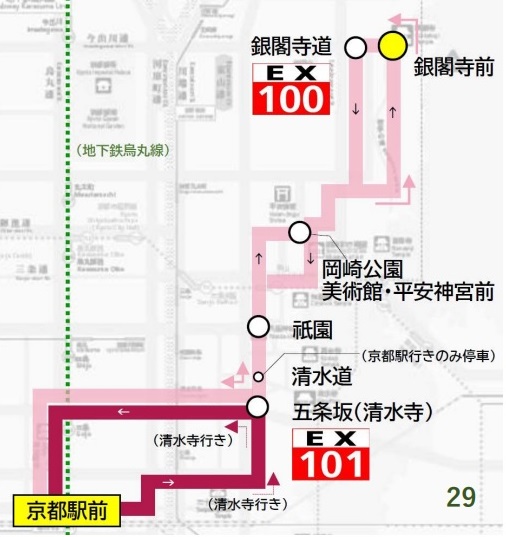
The Tourism Express Buses will run on weekends and holidays, with both routes starting at Kyoto Station . The longer route, designated EX100 , will depart from Kyoto Station and head east into the Higashiyama district, with its first stop at Gojozaka , down the hill from Kiyomizu Temple . The bus will then travel north to its next stop at Gion , Kyoto’s famed geisha quarter , and then to a combined stop for Heian Shrine, Okazaki Park, and the Kyoto Museum of Art . After that, the bus goes further north to Ginkakuji (a.k.a. the Silver Pavilion), stopping once in front of the site and again nearby at Ginkakuji-michi, from where it turns back for the return to Kyoto Station, making one additional stop at Kiyomizu-michi, at the base of the slop that leads to Kiyomizu Temple. A shorter route, EX101 , stops only at Gojozaka before heading back to Kyoto Station. 24 EX100 buses and 16 EX100 will run daily, approximately three each per hour between 9 a.m. and 4 p.m. The new routes will begin running on June 1 .
▼ Ginkakuji, located near the northernmost stop on the Tourism Express Bus route
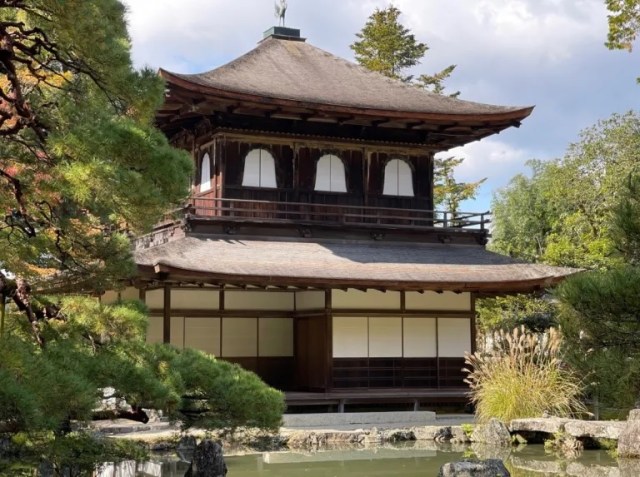
The creation of the Tourism Express Buses doesn’t mean that travelers are barred from using ordinary buses, and locals are likewise allowed to use the nominally for-tourist routes too. Two aspects will likely result in a natural divergence of local and tourist ridership, though .
First, as you can see from the above map, there aren’t a ton of stops on the Tourism Express Bus route . Yes, tourists can easily spend a full-day sightseeing at the spots it provides access to, especially since Ginkakuji is connected to a handful of other temples via the Philosopher’s Path walking street. The absence of stops in any major office, shopping, or residential areas, though, means that there’s little reason for locals to take the Tourism Express Bus while going about their everyday, non-sightseeing lives.
The other divergence factor is the price. A ride on the Tourism Express Bus will cost 500 yen (US$3.35), or 250 yen for children. That’s double the flat fee charged for a ride on normal Kyoto city buses , and while that extra amount is miniscule difference when folded into an entire trip-to-Kyoto/Japan travel budget, residents who are taking the bus dozens or hundreds of times a year will presumably gravitate towards the less expensive standard bus options.
There’s a possibility that extra-thrifty travelers may still feel the allure of the cheaper normal buses, but the smaller number of stops on the Tourism Express Bus routes also mean a shorter ride to the destinations along the way . From Kyoto Station, the ride to Gojozaka is expected to shrink to just 10 minutes, down from the 15 it takes on a normal bus, and the time from Kyoto Station to Ginkakuji is cut almost in half, at only 24 minutes compared to the regular 44. The Tourism Express Bus will also be covered by the 1,100-yen one-day Kyoto bus/subway pass .
One could argue that it’s strange that the Tourism Express Buses will cost more to ride, especially with the truncated EX101 route being so short. After all, if the whole reason they’re being created is because there are so many tourists, it seems there should be enough of an economy of scale to price the Tourism Express Buses like any other. As discussed above, though, the price difference is likely to help separate local and tourist use.
Quibbles about pricing aside, the Tourism Express Bus seems like an idea that’s long overdue. Kyoto has always been a city that attracts travelers, going back to the days when its status as Japan’s capital city made it not just the center for lofty fine arts, but for commerce and commoners’ pursuits too. Its rising popularity as a travel destination continually contributes to an international appreciation and affinity for Japan, and so an initiative like this to help Kyoto continue to be a showcase of Japan’s traditional culture to people from all over the world while still remaining a livable city for those who call it home.
Source: Kyoto City ( 1 , 2 ) Top image: Pakutaso Insert images: Kyoto City , SoraNews24 ● Want to hear about SoraNews24’s latest articles as soon as they’re published? Follow us on Facebook and Twitter !
- ( buses • Kiyomizu Temple • Kyoto • overtourism • tourism • travel )
Related Stories

- Studio Ghibli releases The Boy and the Heron doll that never, ever gives up
- Hit Japanese candy Hi-Chew, famous for fruity taste, releases new flavor: Flavorless
- Comments ( )
- Trackbacks (0)
Leave a Reply
- There are no trackbacks yet.
- Trackback URL
Trending Now
- New definition of “Japanese whiskey” goes into effect to prevent fakes from fooling overseas buyers 30 views
- Solo cherry blossom viewing — 30 percent of young men in survey plan to see sakura alone【Survey】 3 views
- Should you get up early to see the sakura cherry blossoms in Tokyo? 3 views
- Starbucks unveils new Gohobi Frappuccino in Japan 2 views
- We try the free muscle bread distributed by macho dudes at a one-day, pop-up event in Tokyo 2 views
- McDonald’s creates a dream Japanese bento for April Fools’ Day 1 views
- New Pokémon cakes let you eat your way through Pikachu and all the Eevee evolutions 1 views
- Century-old Hiroshima brewery in one of Japan’s three great sake-brewing spots offers tours in English 1 views
- How do European Cup Noodles taste to a Japanese palate? 1 views
- Canned bento?!? We try out a cheaper alternative to canned Yoshinoya【Taste test】 1 views
MOST POPULAR

RECOMMENDED STORIES

- 訪日外国人向けインバウンド広告メディア「SoraNews24」とは?

Follow SoraNews24
© SoraNews24 -Japan News- / SOCIO CORPORATION
- Advertise |
- Work with us |
- Contribution |
Japan tackles overtourism with restrictions for some iconic sites

Mar 27, 2024 • 5 min read
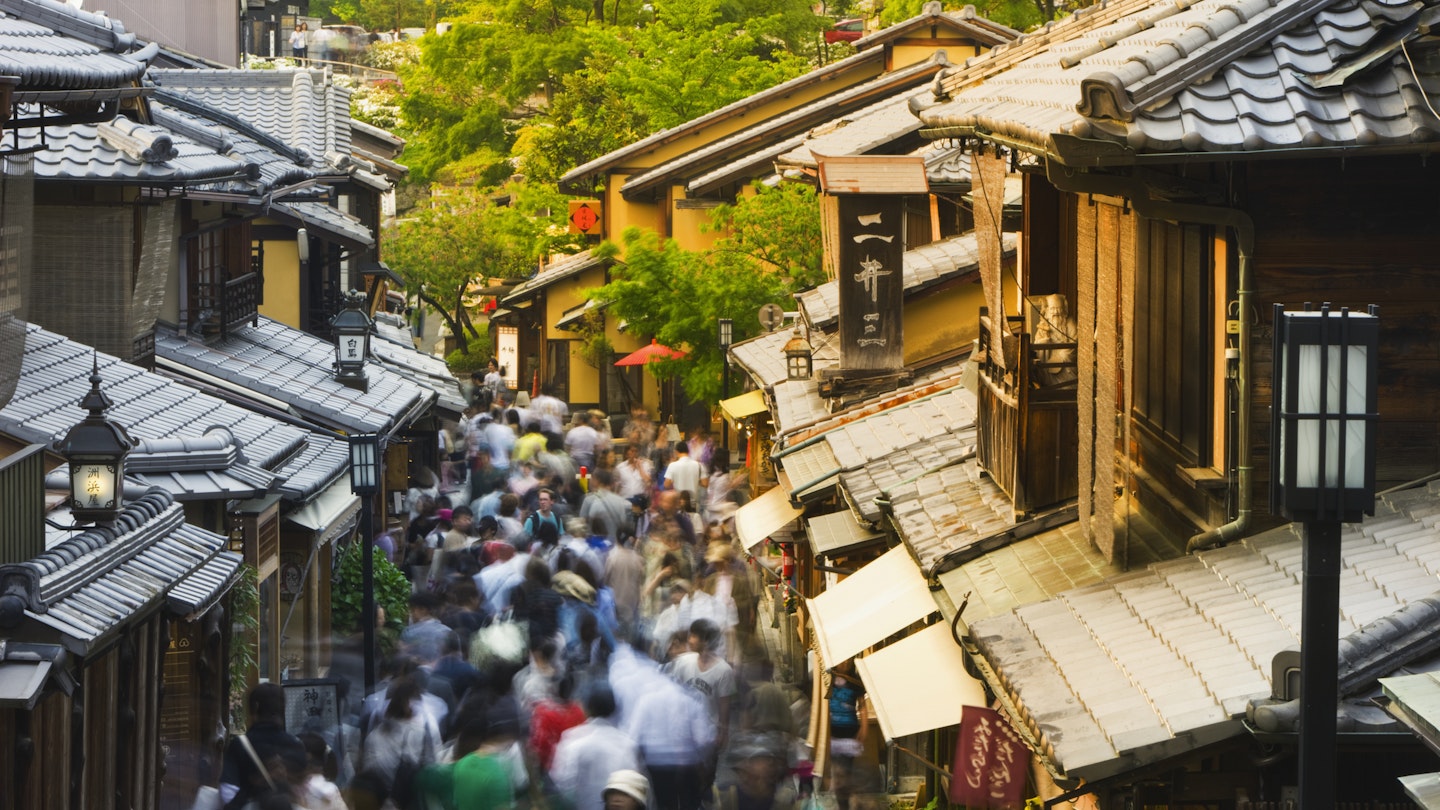
From restricted capacity to increased tourist taxes, options are being considered to counter overtourism in Japan © Jon Hicks / Getty Images
Japan is set to limit visitors at some popular attractions so that sites don't suffer from overtourism. Here's what you need to know.
Japan’s enduring popularity for overseas visitors is bringing consequences as the country seeks to balance the benefits of tourism and the impact on the areas visited, particularly at iconic destinations .
Recently, tourists have been banned from certain private streets in Kyoto ’s famous historic Gion district , traditionally home to the teahouses where geisha (geiko) and maiko (apprentice geiko ) performers work, largely due to antisocial behaviour. Unruly tourists have even been blamed for harassing geisha, with the Japan Times reporting that one had her kimono torn and another had a cigarette butt put in her collar.
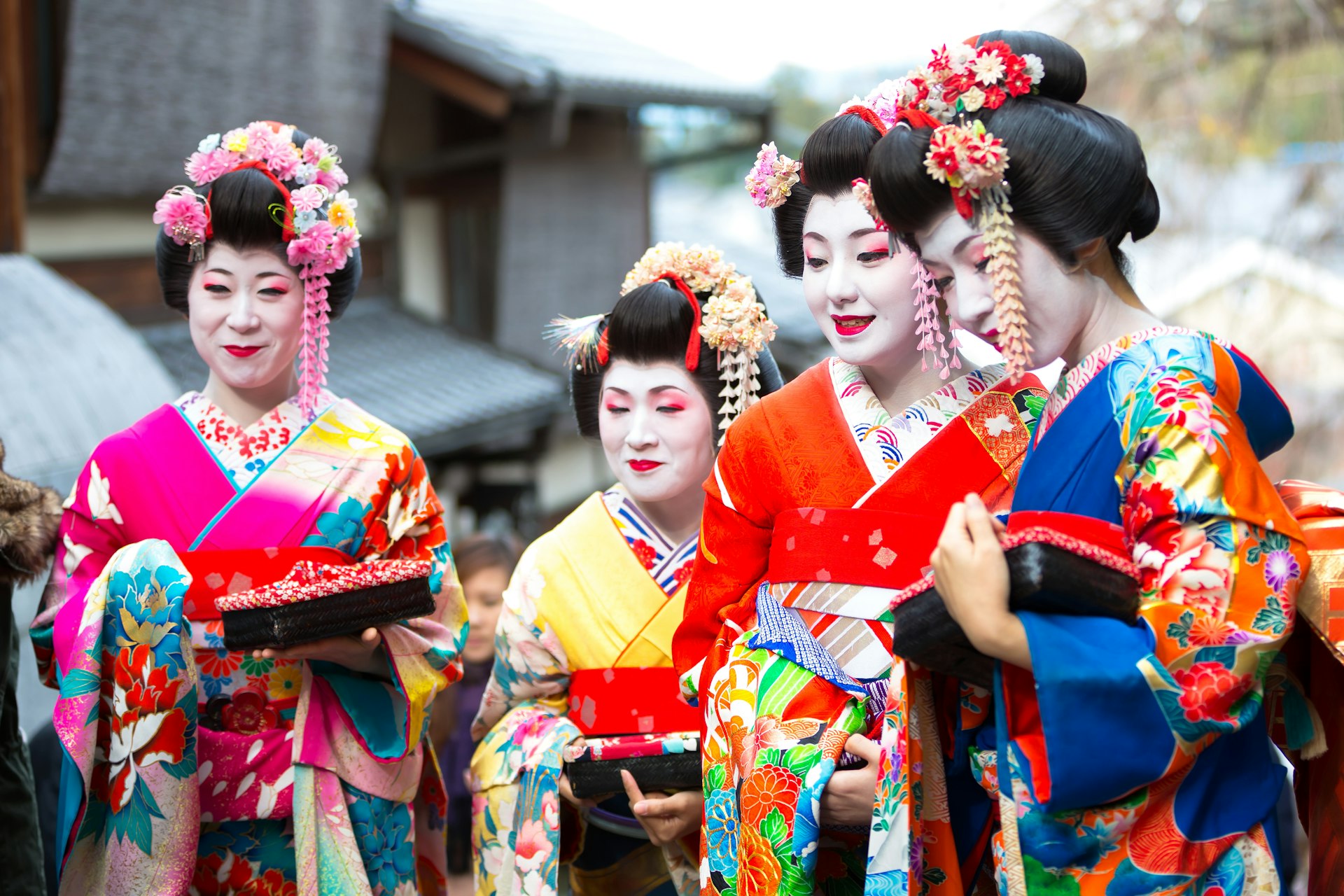
What new policies are being considered?
New fees and restrictions have already been introduced on climbing specific trails up Mt Fuji , in order to combat overcrowding, reduce the environmental impact — including cleaning up all the trash that results from so many people on the mountain — and improve safety for everyone doing the climb.
Kyoto is considering special tourist express bus routes, that will whisk visitors to the city’s most iconic sites in order to reduce overcrowding and improve efficiency on regular local buses, as well as to make what can be a complicated system easier for travelers.
Higher pricing for tourists is also being considered, having largely been absent in Japan, where many of the most famous cultural attractions are surprisingly inexpensive to enter. For example, Kyoto's famous golden temple Kinkaku-ji costs ¥400 for adults, which is about US$2.50. Changing this would be controversial, and it seems more likely that there would be increases in tourist taxes in order to fund services for visitors.
What are tourist taxes used for?
Local tourist taxes, usually collected as an extra on top of payment for your hotel, are common across many parts of the world, although these are relatively low in Japan compared with, say, destinations in the US like Honolulu and San Francisco.
These aim to fund some of the local costs associated with visitors: Kyoto’s is on a sliding scale based on the price of your hotel room, from ¥200–1000 a night (about US$1–7). The city of Hatsukaichi, home to the UNESCO-listed Itsukushima-jinja , often known as Miyajima and famous for its torii gate standing in the water off the island, recently implemented a ¥100 (about US$0.60) fee to fund the preservation and management of the site.
Japan already has a ¥1000 (about US$7) tourist departure tax that you may have never noticed as part of your plane fare.
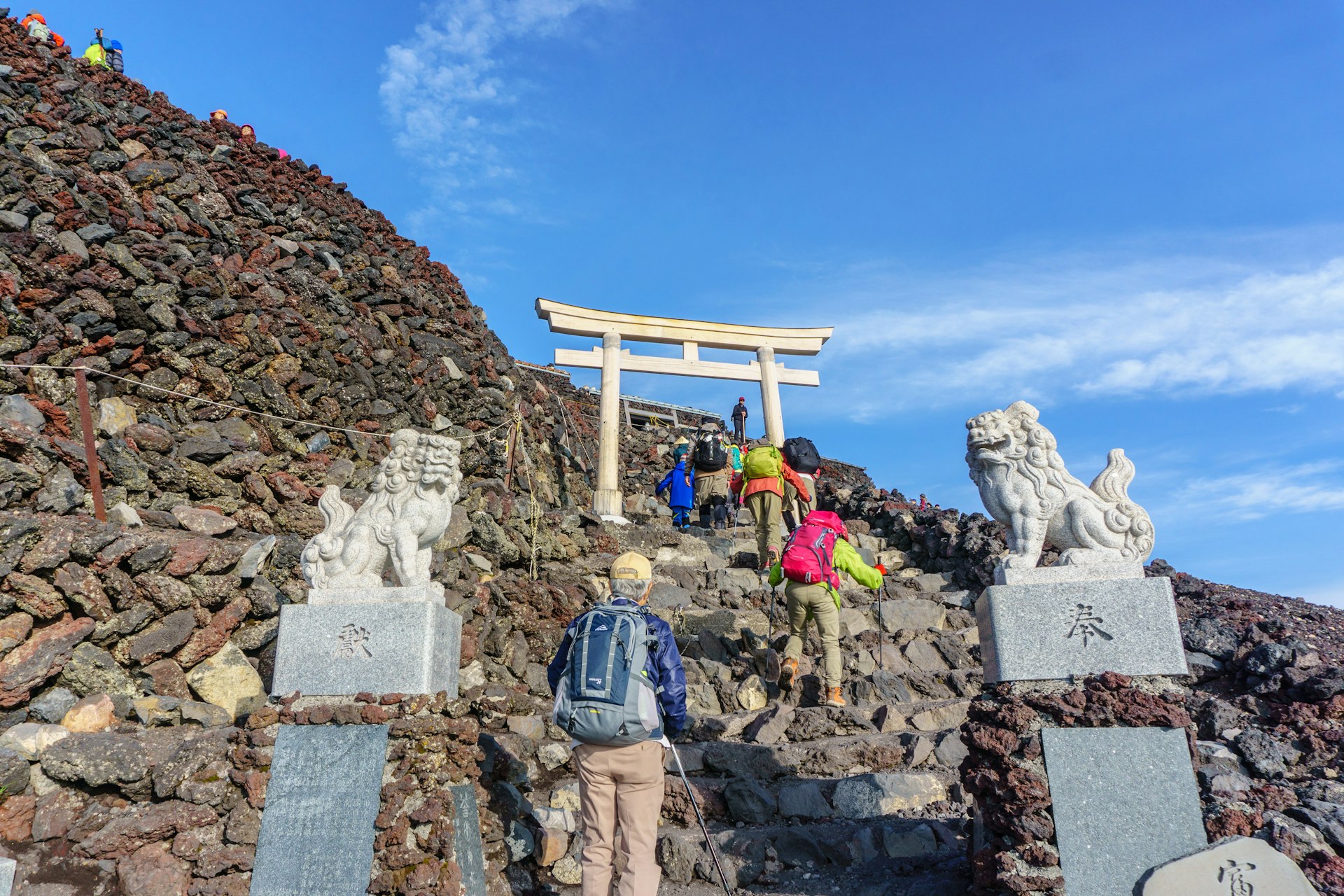
How is Japan likely to manage the problems of overtourism?
It seems unlikely that Japan will curtail its overall number of visitors because of overtourism. More likely, we’ll see more examples of capacity restrictions in specific places, like on Mt Fuji, where a certain number of people per day are allowed in.
This already happens in some cases in Japan: the famous Ghibli Museum in Tokyo and the new Ghibli Park in Nagoya both have a ticket maximum to maintain the quality of experience and to avoid overcrowding — the price for the former is just ¥1000 or about US$6.50, so it really is about capacity.
Some trains — specifically the fastest Nozomi and Mizuho Shinkansen between points west of Tokyo — are not included as part of the Japan Rail Pass , even though the slightly slower trains like the Hikari are. There’s only a few minutes' difference in terms of travel time, but at peak times there can be a half-dozen of the faster trains for every one of the slower ones. This is done for a variety of reasons, including that the clockwork-like efficiency of the shinkansen’s busiest section leaves only the briefest times for passengers to get on and off the train, and confused tourists (often carting large luggage with them) have been known to disrupt operations. Overseas visitors are therefore concentrated into the slightly slower Hikari and much slower Kodama services instead.
A more recent change is the 2020 introduction of the “Baggage 160” system , where travelers must reserve a space for larger pieces of luggage (over 160cm/63in in combined height, width and depth) on more popular bullet train lines or pay a carry-on fee. The change largely stemmed from the complications of visitors bringing large pieces of luggage onto trains that were not designed with large luggage storage. Japanese travelers tend not to bring large suitcases with them on trains, instead shipping them ahead to their destination via the excellent and inexpensive set of luggage delivery services like Yamato Transport , known as kuroneko (black cat) after its ubiquitous logo of a black cat carrying a kitten in its mouth.

How will this impact on group tours?
Keep an eye out for capacity management caps or even outright bans to potentially affect group tours first. These can be very unpopular with local people, and indeed with other visitors.
A tour bus full of visitors descending all at once can change the character of a place instantly, and that’s certainly the case in a lot of the most famous Kyoto temples and shrines like Kinkaju-ji, Ryōan-ji or Kiyomizu-dera . These groups often have a reputation for behaving disrespectfully, like talking loudly in places where quiet is expected, not following rules, and getting in the way of local people and more respectful travelers.
You’re unlikely to be affected as an independent traveler, and a smart tactic is to visit at times when these groups are either still making their way from their hotels, have been packed off for lunch, or are heading back at the end of the day — and to plan to explore the less-traveled corners of this fascinating country.
Explore related stories
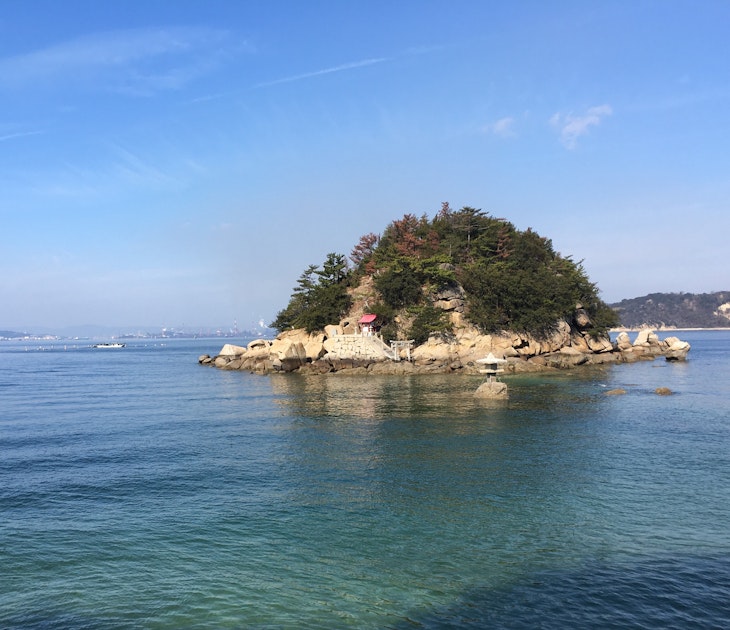
Mar 4, 2020 • 5 min read
Step away from Japan's big cities and sample some slow travel in and around the Seto Inland Sea.
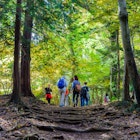
Feb 5, 2020 • 4 min read

Apr 2, 2024 • 10 min read

Mar 28, 2024 • 7 min read

Mar 21, 2024 • 9 min read

Feb 21, 2024 • 7 min read

Feb 11, 2024 • 11 min read
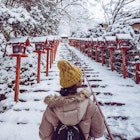
Jan 18, 2024 • 8 min read
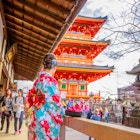
Dec 10, 2023 • 6 min read

Mar 7, 2023 • 7 min read
- Japan Tourism
- Japan Hotels
- Japan Bed and Breakfast
- Japan Vacation Rentals
- Flights to Japan
- Japan Restaurants
- Things to Do in Japan
- Japan Travel Forum
- Japan Photos
- All Japan Hotels
- Japan Hotel Deals
- Last Minute Hotels in Japan
- Things to Do
- Restaurants
- Vacation Rentals
- Travel Stories
- Rental Cars
- Add a Place
- Travel Forum
- Travelers' Choice
- Help Center
Visit to Tokyo and Kyoto. March 29; 8 nights; Observation - Japan Forum
- Asia
- Japan
Visit to Tokyo and Kyoto. March 29; 8 nights; Observation
- United States Forums
- Europe Forums
- Canada Forums
- Asia Forums
- Central America Forums
- Africa Forums
- Caribbean Forums
- Mexico Forums
- South Pacific Forums
- South America Forums
- Middle East Forums
- Honeymoons and Romance
- Business Travel
- Train Travel
- Traveling With Disabilities
- Tripadvisor Support
- Solo Travel
- Bargain Travel
- Timeshares / Vacation Rentals
- Asia forums
- Japan forum

1. I had read that Haneda airport to Tokyo city by taxi is a fixed charge. But not so in our case. Afternoon taxi ride from Haneda airport to Tokyo station , cost was J Yen 9600.
2. After reading one of the forum postings, we took a guide for local sightseeing ( 1 day ) at Tokyo and Kyoto through GoWithGuide.com. It was bad experience. English communication very poor. No information about the sites or history of Japan . On occasions even bus / train routes were not known by the Guide. I had more information about local commuting by train or bus than the guide. A waste of money. The booking was done after reading highly rated reviews for the Guide. My observation is that 1, there is no need to hire a guide. 2, Google search gives more information. 3, Google maps and a translation App is what is required on your phone. 4, Tokyo is a train city. Kyoto is bus city.
3. Bought a Welcome Suica card ( I C card ) on landing at Haneda Airport. First purchase can be made by using a credit card. Subsequently recharge through cash. Used it in Tokyo, Kyoto, and Osaka .
4. Japan is a ' cash usage city ' . Must carry cash with you always. Eg even a Subway outlet in Osaka was ' cash only '. In Nara also to have cash with you is a must. The shrines and temples that have an entry ticket, accept only cash.
5. One ' blog ' that I had read mentioned about toilet paper not being available at Restroom in stations. This is not so. Restrooms available in restaurants, at all stations and other sites like museums. At Kawaguchiko we visited a Museum to use restroom only.
6. In Kyoto one takes a bus to move around. Easy and quite fast. Fixed charge for adults is J yen 230 for each trip on board. Any number of stops for 1 trip. IC card can be used. Only exact 230 fare to be paid in cash. No return of cash if excess paid. Driver has no cash to return. Some buses will have a cash coin vending machine near the driver. Only J yen 1000 can be used. There is a J yen 1100 cost daily bus pass also available. Any number of trips on bus and subway. Remember that mostly the buses have a circular route. Announcement in bus both in Japanese and English.
( first post of our trip ) .

2. Sorry about your bad experience. No need to go with a guide, unless you know it's a reputable company and the guides are knowledgeable. There are many good companies and good guides.
4. Yes, cash is always king in Japan . Especially now, with so many tourists, many privately owned shops, restaurants, and bars have a sign that says "Cash Only." Japanese Yen is the only currency that can be used in Japan. If you are using a credit card and there is a choice to use the currency of your country or a "local" one, ie Japanese Yen, always choose "local." You will get better rates.
5. Japan has, hands down, the best public toilets. You won't need to take toilet paper any more (although at time, a couple of decades ago, we needed to carry tissue paper), but it's best to have a small towel for drying your hands.
6. Having an IC transportation card or app on your phone is the easiest way to travel. There are some train lines that will not accept IC cards. You will need to pay for those tickets with cash.
Thank you for your observations.
- Which bus seats: Matsumoto -> Kamikochi 6:37 am
- JREast South Hokkaido Pass 6:04 am
- What to should I arrive at New Chitose Airport 6:00 am
- Car rental 5:58 am
- Universal Studios 'Timed Entry' 5:48 am
- Prepaid SIM from KIX airport 5:45 am
- Return train ride back to Kyoto 5:43 am
- Aoniyoshi train - do I need to reserve? 5:41 am
- Advice on Itinerary for 5 weeks 5:33 am
- Need Advice on Sequence of Visits 5:27 am
- Visit Japan Web 5:09 am
- Accommodation in Furano or Biei 4:47 am
- Reserved table at restaurant 4:15 am
- One day in Tokyo before cruise of Japan 4:11 am
- 'semi double' rooms 5 replies
- Pocket WiFi Rental Experience? 315 replies
- kyoto-takayama JR or Lmtd express??? 6 replies
- Best Japan travel guide book? 29 replies
- Best/cheapest time of year to visit?? 3 replies
- Radiation danger in Tokyo? 37 replies
- Best Skiing in Japan? And When? 3 replies
- Japan in 10 days 3 replies
- How far is Nara from Kyoto 8 replies
- how to get to Hokkaido from Tokyo? confused..pls HELP. 5 replies
- 2024 public holiday chart in East Asian countries
- Where can I find more onsen in Japan?
- Driving Information
- Catholic mass in English and other languages
- How can we access tourist attraction from cruise port?
- Pocket WiFi Rental Experience?
- Halal Information
- Tokyo trip report here

- Share full article
Advertisement
Supported by
In Kyoto, Five Hotels to Add to Your Travel Wish List
The city’s newest crop of hotels — from a luxury retreat on a historic estate to a 10-room inn surrounded by forested mountains — were worth the wait.

By John Wogan
The pandemic lockdown in Japan coincided with a flurry of new hotels, especially in Kyoto, where the Park Hyatt, Aman and Four Seasons were joined by a group of independent properties and the first Ace hotel in the archipelago. When the country finally reopened to foreign visitors in October 2022, tourists came flooding back to the city of 800-year-old temples and bamboo forests spoiled for choice of accommodations, at a range of prices. The number continues to grow: Next month, the wellness-focused Six Senses brand will open its first Japanese outpost in the city’s Higashiyama district, home to many of the main tourist sites. Here, a look at five of Kyoto’s newer hotels that are redefining the city’s hospitality scene.
Hotel the Mitsui Kyoto
Andre Fu, the interior designer behind hotels like the Upper House in Hong Kong and Villa La Coste in Aix-en-Provence, France, has infused his signature aesthetic (extravagantly refined, with warm woods and luxurious textures) within the confines of a particularly historic area of Kyoto. The 161-room Mitsui, opened in late 2020, sits across from Nijo Castle, an enormous 17th-century compound and a UNESCO World Heritage site. It’s in stark contrast to the hotel, whose only timeworn element is an imposing entrance gate — a traditional wood structure over 300 years old and a remnant of the days when the Mitsui family lived on the grounds. Once past the gate, you’ll find a glass-and-steel building, designed by the Japanese architect Akira Kuryu, and landscaping that’s meant to echo the original garden pathways of the Mitsui residence, planted with cherry trees and steppingstones that meander above a glassy pond. The four food and drink venues include the French-Japanese Toki, overseen by the chef Tetsuya Asano (previously of the Ritz Paris), and the Garden Bar, strategically positioned to capture seasonal views, like the spring cherry blossoms and blazing autumnal foliage, out of massive double windows. Rooms from about $1,360 a night.
Ace Hotel Kyoto
The youthful Ace hotel brand might seem like an odd fit in staid Kyoto. But this 213-room property, which opened in 2020, fits seamlessly into the city center thanks to a collaboration between the Japanese architect Kengo Kuma and the California-based design firm Commune. Kuma, who designed the Japan National Stadium (the centerpiece of the 2021 Tokyo Olympics), renovated the imposing 1920s-era, red brick Kyoto Central Telephone Office, while adding an industrial-looking building — sheathed in copper sulfide plating, cedar, glass and concrete — next door. Commune infused the guest rooms with Ace’s signature mix of bright colors and patterns: original dyed prints from the Japanese folk artist Samuro Yunoki sit alongside Tivoli radios, turntables and vintage records. The most popular part of the hotel, though, might be the street-level branch of Stumptown Coffee Roasters — the first in Japan. From about $300 a night.
Arashiyama House Mama
Like Kyoto’s dozens of temple gardens, this 10-room property offers an immediate sense of calm. Its entrance is so discreet, you could easily miss it. (Look for the flowing white cloth curtain with simple black signage, behind which is a garden path leading to a minimalist building made of wood, concrete and glass.) The hotel’s location informs the interior design: Thirty minutes west of central Kyoto, the Arashiyama district is defined by nature, with the Katsura River at its center, and filled with bamboo groves and surrounded by forested mountains. Guest rooms are simply furnished with beds, chairs and tables handmade by both Kyoto artisans and the Danish furniture maker Carl Hansen & Son, and each one has a soaking tub. Rooms from about $540 a night.
The Shinmonzen
The Gion district epitomizes Kyoto for many visitors, with its maze of narrow alleys and ryokans, traditional Japanese inns. It’s here, on a quiet side street among artists’ studios, antique shops and galleries, that the Shinmonzen opened in December 2021. Although it’s a new build, the aim was for the hotel to blend in with the surrounding structures. To accomplish this, the famed Japanese architect Tadao Ando created a wooden facade that replicates a machiya , one of the venerable townhouses found throughout Kyoto. There are only nine guest rooms, but they’re unusually spacious, and all have balconies with views of the Shirakawa River. Each one is an ode to Japanese interior elements, furnished with tatami mats, shoji (panels lined with rice paper) and cypress soaking tubs. And for dining, the chef Jean-Georges Vongerichten, whose restaurant empire spans the world, devised a menu blending French, American and Asian influences, sourcing much of the produce from local farms. Rooms from about $1,500 a night.
Maana Kiyomizu
A three-suite hotel near the 16th-century Toyokuni Shrine, Maana Kiyomizu is the latest offering from Maana Homes, the small local hospitality group, which operates two other properties in the city. This one, opened in the winter of 2022, is located in Higashiyama, and is a complex of four machiya that also houses POJ Studio — a boutique that sells artisanal Japanese crafts and home goods. There’s also Kissa Kishin, the second branch of a popular Gion cafe, which serves coffee, matcha and pastries and acts as the unofficial social center for the property. The Japanese architects Uoya Shigenori and Takeshi Ikei renovated the suites to create a minimalist wabi-sabi ideal of city living, where handmade pottery from Shigaraki (a town famous for its ceramics) are the only decorative flourishes to be found. Rooms from about $560 a night.
Explore T Magazine
Fashion’s Latest Muses: An industry long known for revering willowy bodies is taking a new interest in muscle with female bodybuilders as models.
Objects That Inspire: Simone Bellotti, the creative director of Bally, shares his influences including club DJs, fishing apparel and ceremonial masks.
Rome’s Esquilino Neighborhood: Set between the Colosseum and the tracks leading to Termini station, Rome’s Esquilino neighborhood occupies the Esquiline Hill, one of the city’s seven ancient mounds . Here’s where to go.
Fashion for the Sun: A touch of transparency balances the season’s rich, saturated hues.
Furniture From the Last 100 Years: Three designers, a museum curator, an artist and a design-savvy actress convened to make a list of the most enduring and significant objects for living.
Writing in a Tuscan Villa: Albert Moya has optimized his apartment , part of a 14th-century estate in the hills of Florence, for work and lounging.

Passing Thru Travel
Exploring 10 Cities Around the World by Bike – Pedal-Powered Discoveries 2024
Posted: February 25, 2024 | Last updated: February 25, 2024
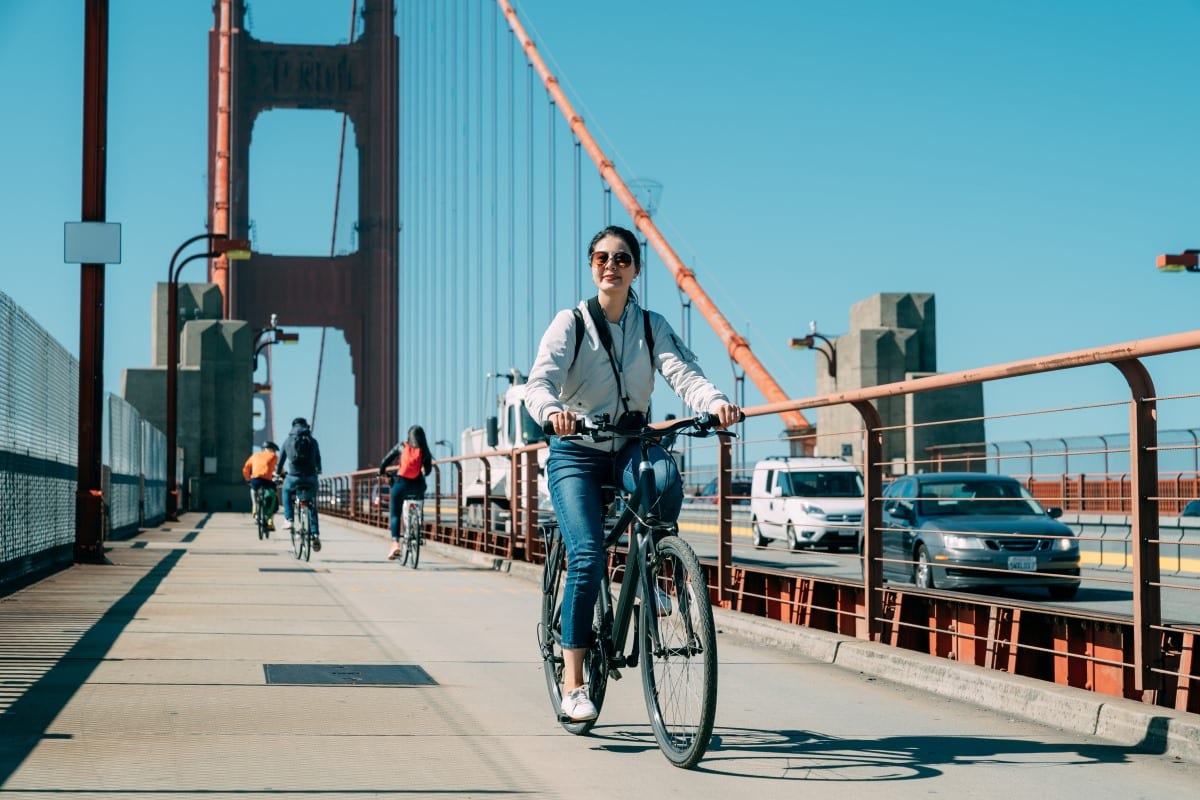
Sustainable city cycling tours offer an eco-friendly and intimate way to explore urban landscapes. These tours allow you to navigate through the heart of cities, often uncovering hidden gems that are not accessible by car or bus. From the bustling streets of Amsterdam to the historic lanes of Kyoto, cycling tours provide a unique perspective on city life, culture, and architecture. This guide takes you on a two-wheeled journey through some of the best cities in the world to explore by bike, each offering a distinct and memorable experience.
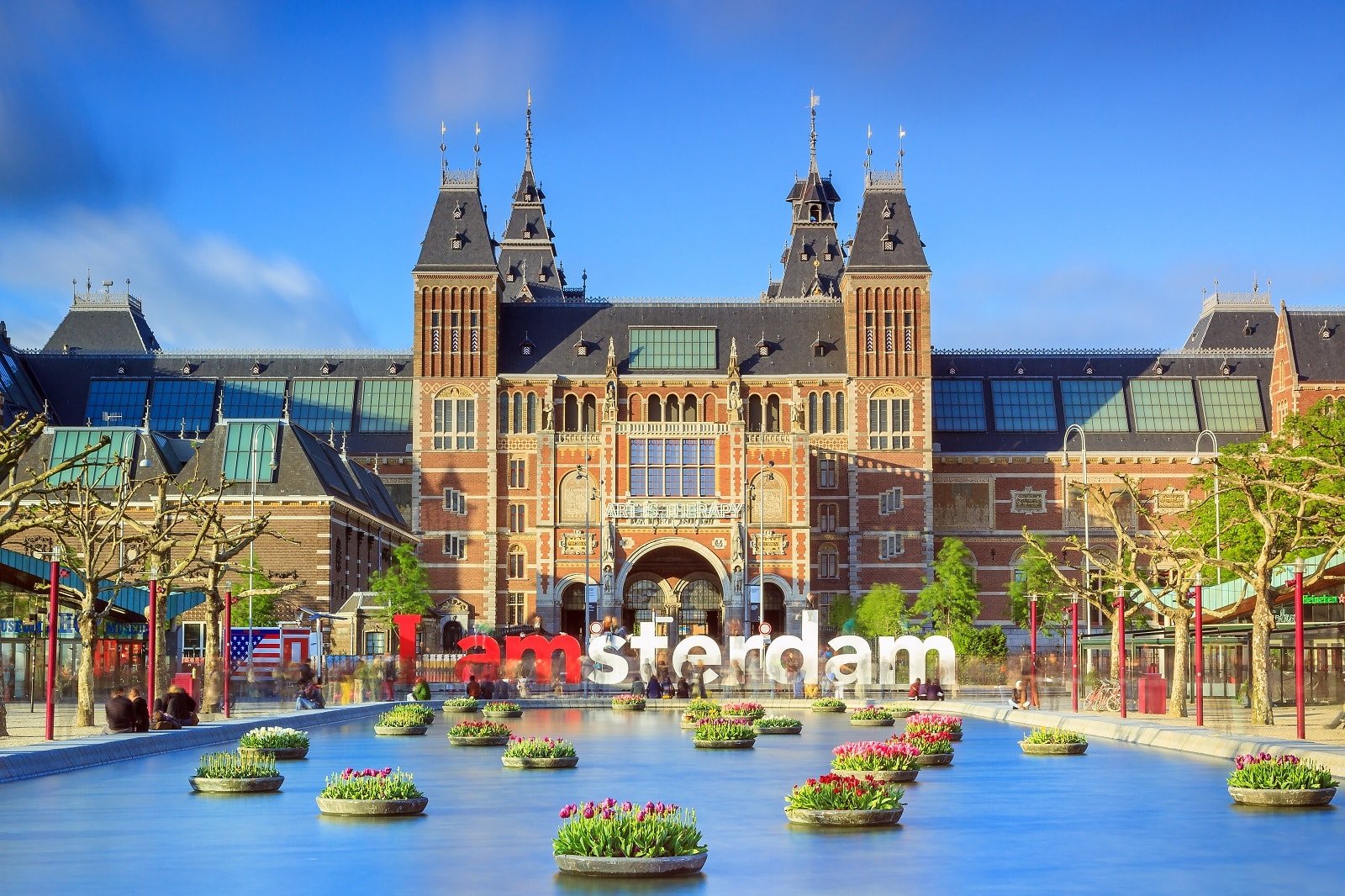
1. Amsterdam, Netherlands
In Amsterdam, cycling is more than a mode of transport; it’s a way of life. The city’s flat terrain, dedicated bike lanes, and respectful traffic culture make it ideal for exploring on two wheels. A bike tour here lets you experience the city like a local, weaving through historic canals, past iconic windmills, and through vibrant neighborhoods like the Jordaan. You’ll discover hidden courtyards and bustling marketplaces and perhaps pause for a coffee at a canal-side café. Cycling in Amsterdam offers a blend of leisure and exploration, allowing you to cover more ground than walking while enjoying the city’s sights up close.
Insider’s Tip: Explore the Jordaan neighborhood to glimpse local Amsterdam life away from the tourist crowds.
When To Travel: Late spring to early fall offers pleasant weather for cycling.
How To Get There: Fly into Amsterdam Airport Schiphol. The city center is easily accessible by train, and bike rentals are widely available.
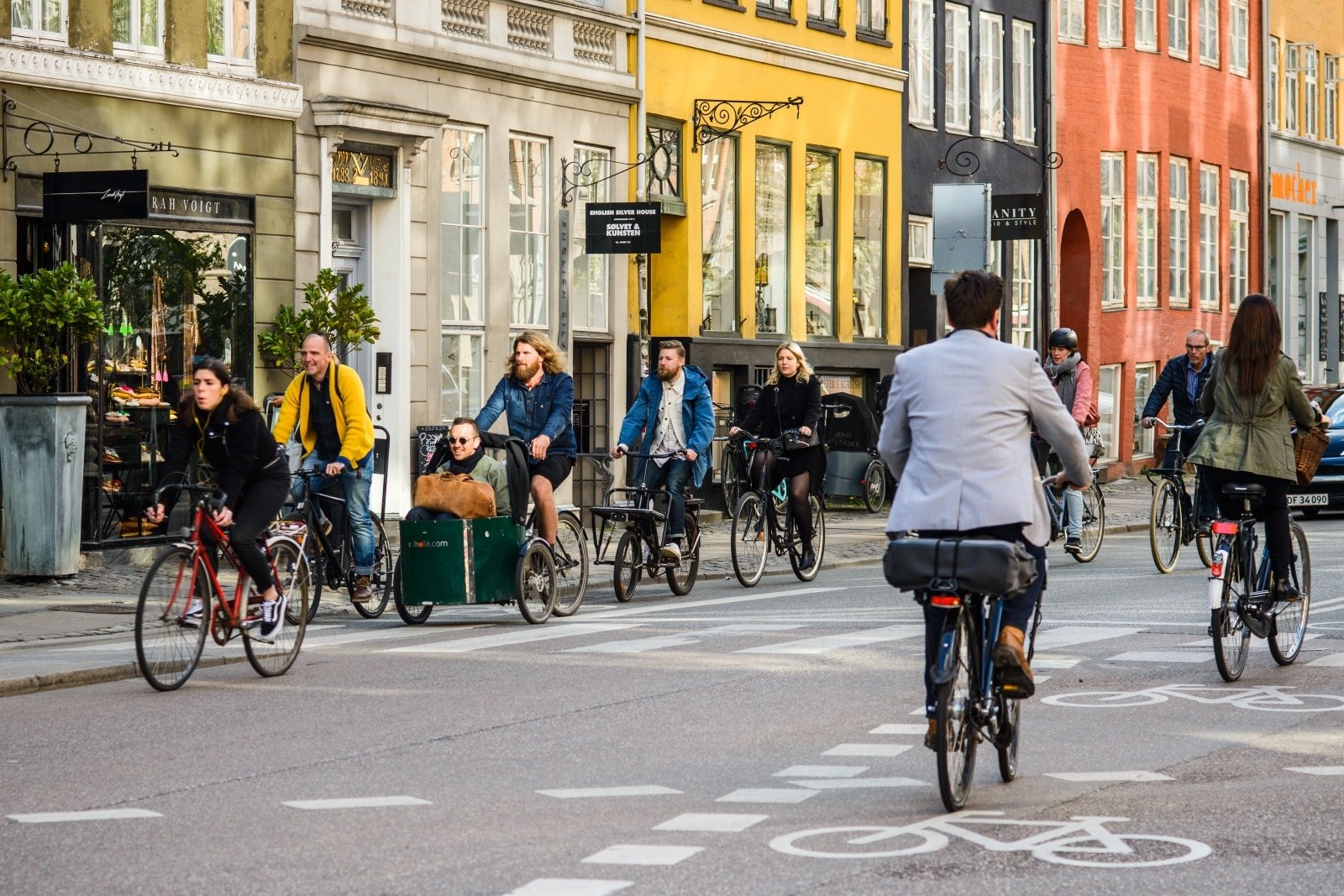
2. Copenhagen, Denmark
Copenhagen’s reputation as a bike-friendly city is well-earned. Its extensive network of bike lanes and the Danish culture of cycling make it a joy to explore on two wheels. A bike tour in Copenhagen might include the historic Nyhavn harbor, the whimsical Tivoli Gardens, and the modern architecture of the Ørestad district. Riding through Copenhagen, you’ll experience the city’s commitment to sustainability and quality of life. The tour is not just about seeing the sights; it’s about feeling the city’s pulse and understanding why Copenhagen is often ranked as one of the happiest cities in the world.
Insider’s Tip: Ride through the Assistens Cemetery, a peaceful and beautiful park where famous Danes like Hans Christian Andersen are buried.
When To Travel: May to September for the best cycling weather.
How To Get There: Copenhagen Airport is well-connected internationally, with easy public transport access to the city center.
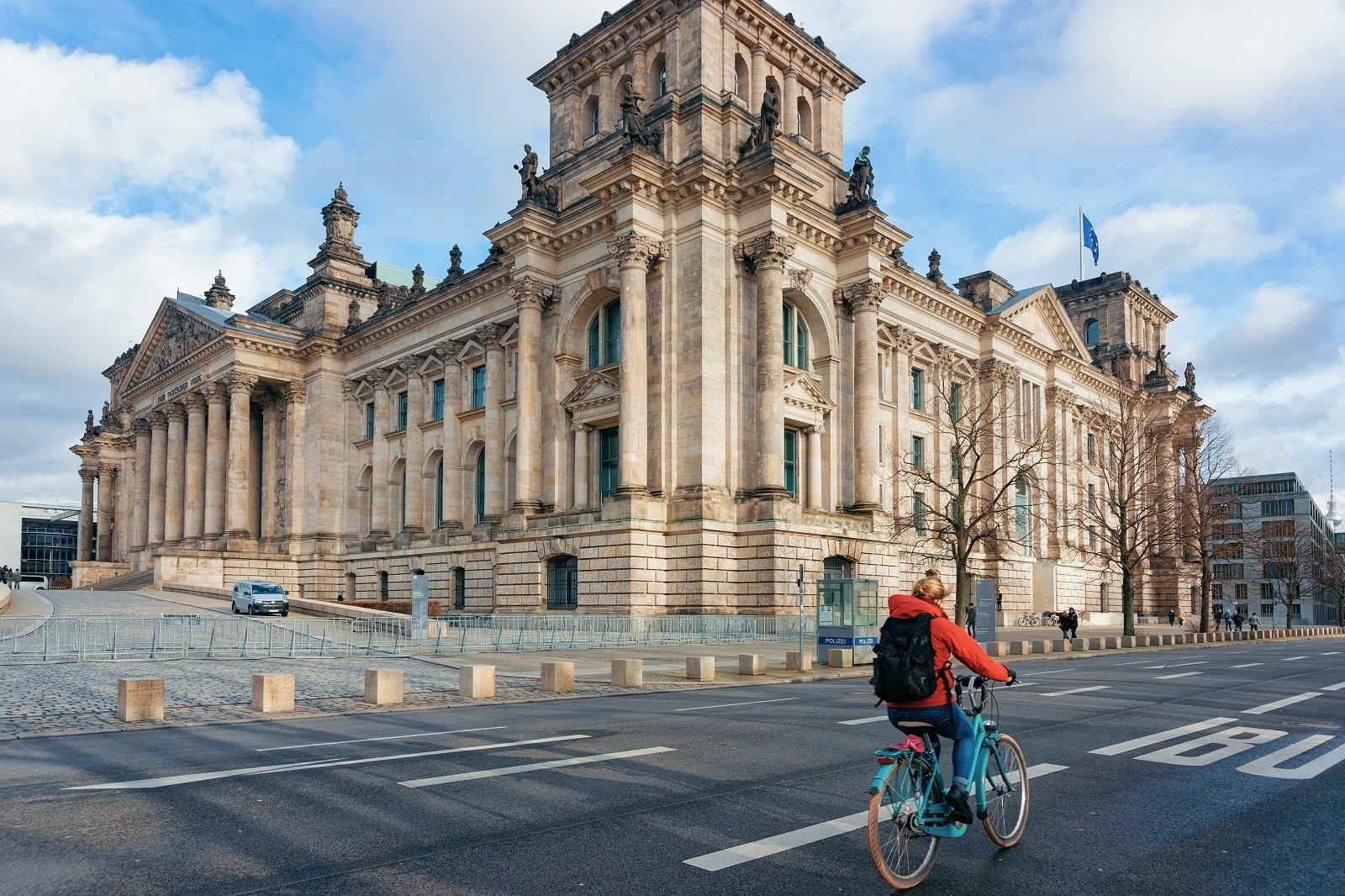
3. Berlin, Germany
Berlin’s rich history and vibrant culture make it a fascinating city to explore by bike. The city’s flat landscape and comprehensive network of bike paths allow for easy and safe navigation. A cycling tour in Berlin can take you through the remnants of the Berlin Wall, the lush expanses of the Tiergarten, and the bustling squares of Alexanderplatz and Potsdamer Platz.
Along the way, you’ll encounter street art, historic landmarks, and the eclectic mix of modern and traditional architecture that defines Berlin. Cycling here offers a unique perspective on the city’s past and present, connecting you with its stories and spirit.
Insider’s Tip: Visit the Tempelhofer Feld, a former airport turned public park, for a unique cycling experience.
When To Travel: Spring and fall offer cooler temperatures and fewer tourists.
How To Get There: Two airports serve Berlin, with excellent public transportation links to the city center.
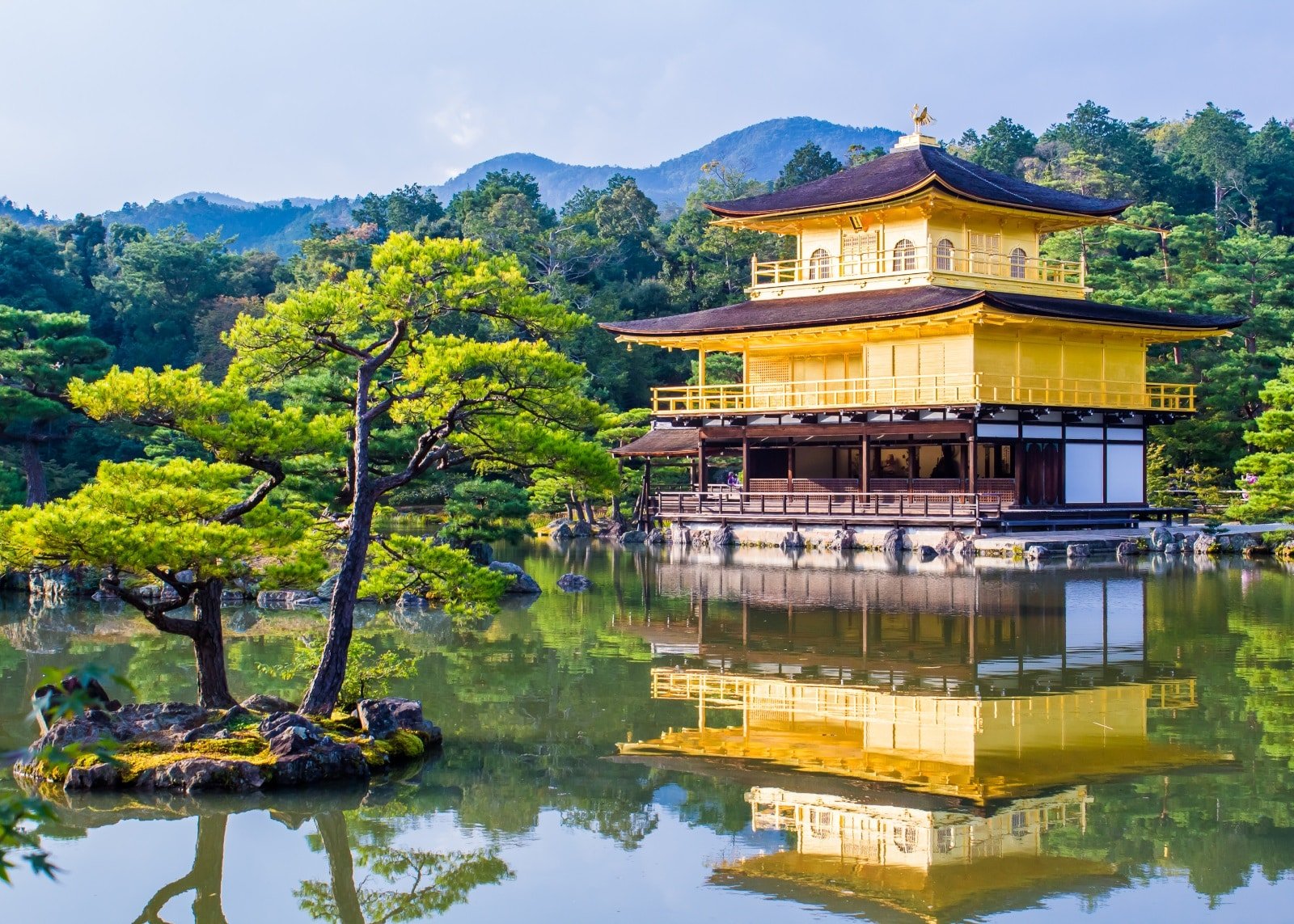
4. Kyoto, Japan
Kyoto, with its ancient temples, traditional tea houses, and tranquil gardens, is a city steeped in history. Exploring Kyoto by bike allows you to move at your own pace, visit famous sites like the Fushimi Inari Shrine and Kinkaku-ji (Golden Pavilion), and discover hidden alleys and local neighborhoods. Cycling in Kyoto is a journey through time, where modern streets give way to historic districts, and each turn brings a new discovery. The city’s respect for tradition and nature makes it a uniquely serene urban cycling experience.
Insider’s Tip: Take a detour to the Philosopher’s Path, especially beautiful during cherry blossom season.
When To Travel: Spring for cherry blossoms and fall for colorful foliage.
How To Get There: Fly into Kansai International Airport and take a train or bus to Kyoto. Bike rentals are readily available throughout the city.

5. Barcelona, Spain
Barcelona’s diverse landscape, from Gothic architecture in the old city to modernist landmarks and Mediterranean beaches, makes it an exhilarating city to explore by bike. A cycling tour here can take you through the winding streets of the Gothic Quarter, along the vibrant Las Ramblas, and to the famous Sagrada Familia. You’ll experience the city’s artistic flair and lively atmosphere firsthand. Cycling in Barcelona is not just about sightseeing; it’s about immersing yourself in the city’s dynamic culture and enjoying the Mediterranean lifestyle.
Insider’s Tip: Cycle up to Montjuic for panoramic views of the city and the sea.
When To Travel: Late spring and early fall for mild weather and fewer crowds.
How To Get There: Barcelona-El Prat Airport is the main gateway, with easy transport options to the city center.
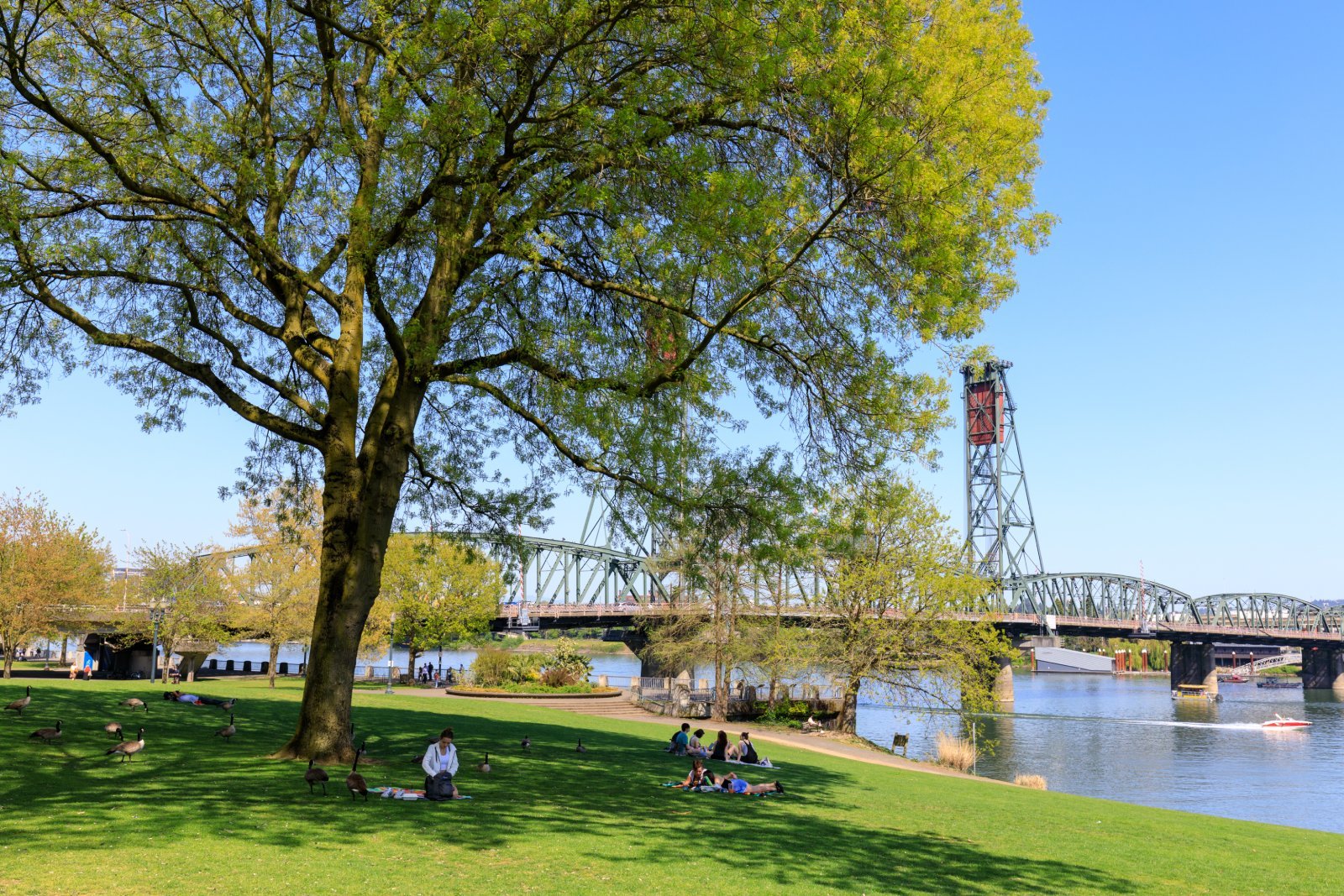
6. Portland, Oregon, USA
Portland’s reputation as one of America’s most bike-friendly cities is evident in its extensive bike lanes and trails network. A bike tour in Portland can include the vibrant downtown area, the serene Waterfront Park, and the quirky neighborhoods that give the city its unique character. With stops at local markets, artisan coffee shops, and craft breweries, you’ll discover Portland’s commitment to sustainability and community. Cycling in Portland is an opportunity to experience the city’s green ethos and creative spirit up close.
Insider’s Tip: Check out the Eastbank Esplanade for a scenic ride along the river.
When To Travel: Summer for the best weather and numerous cycling events.
How To Get There: Fly into Portland International Airport. The city center is easily accessible by public transport, and bike rentals are available throughout Portland.
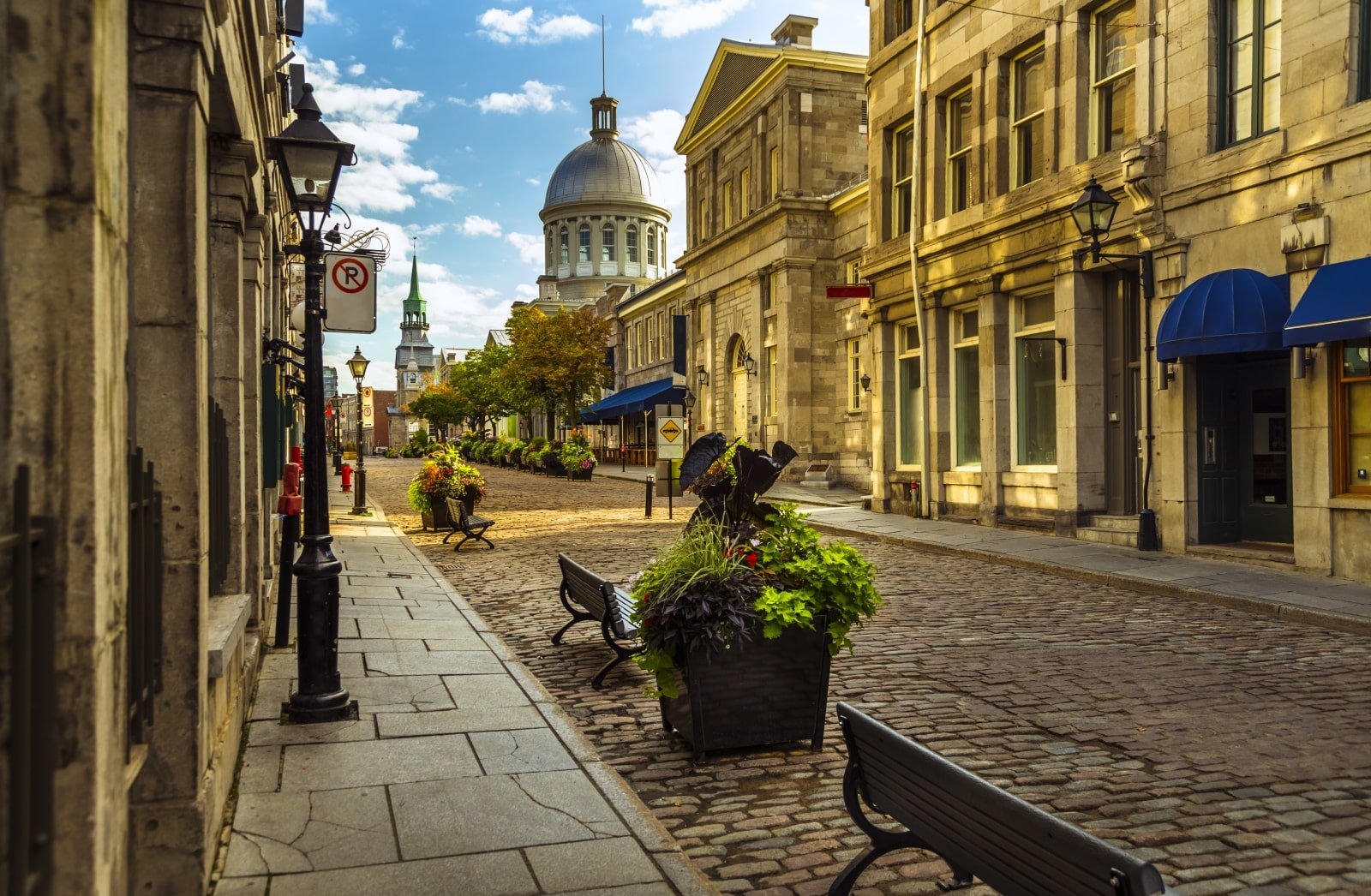
7. Montreal, Canada
Montreal combines the charm of a French village with the energy of a cosmopolitan city, and exploring it by bike allows you to experience this blend firsthand. A cycling tour in Montreal might include the historic streets of Old Montreal, the bustling Atwater Market, and the scenic Lachine Canal. The city’s bike paths, like the Route Verte, make navigating easy and safe. Cycling in Montreal offers a unique way to experience the city’s diverse neighborhoods, rich history, and vibrant culinary scene.
Insider’s Tip: Ride to the top of Mount Royal for a stunning view of the city.
When To Travel: Late spring to early fall for the best cycling conditions.
How To Get There: Montreal-Trudeau Airport is the main entry point, with good public transportation options to the city.
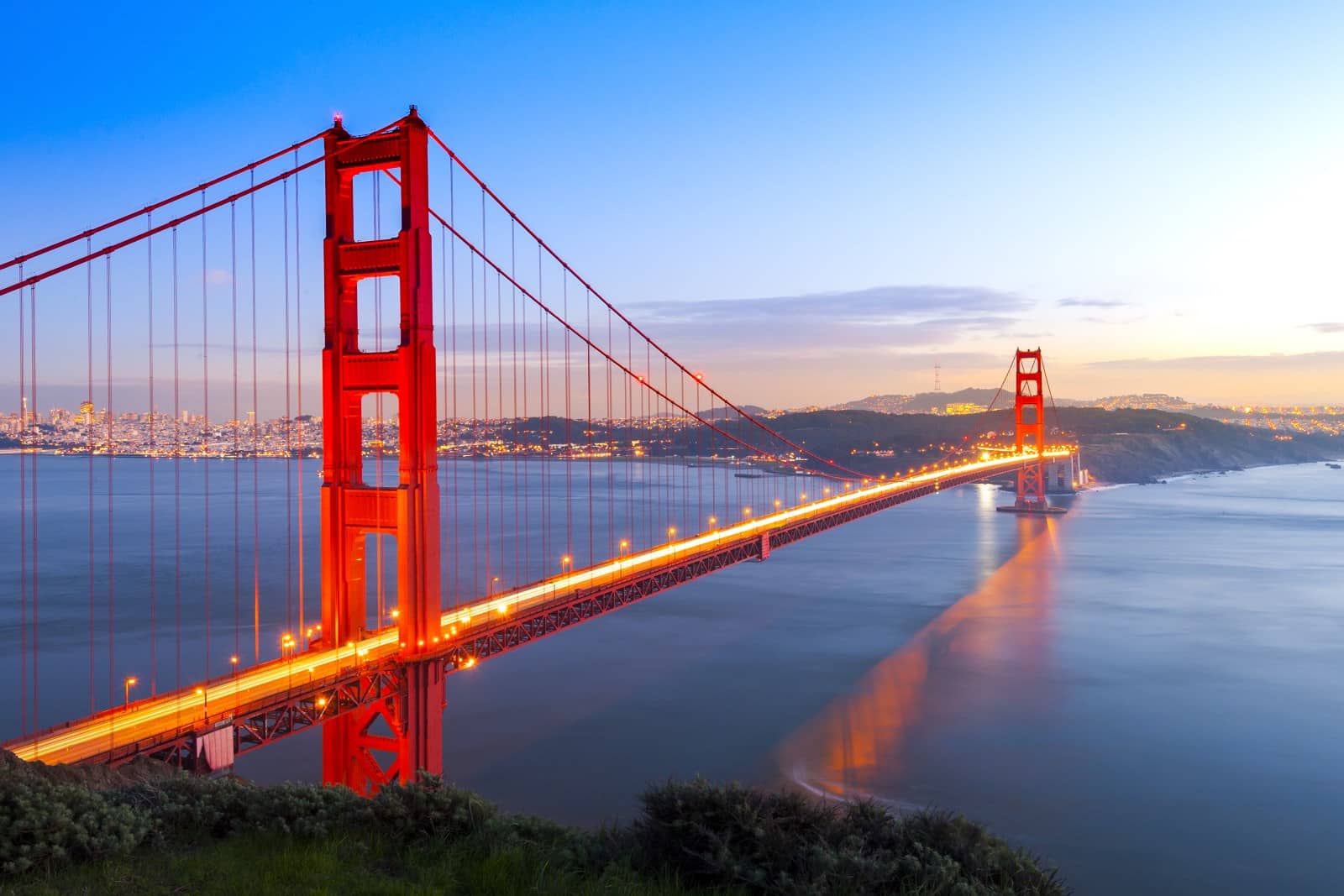
8. San Francisco, California, USA
San Francisco’s iconic landmarks and diverse neighborhoods make it a fascinating city to explore by bike. Despite its famous hills, there are plenty of flat and scenic routes, especially along the waterfront and the city’s many parks. A bike tour in San Francisco might include the Golden Gate Bridge, Fisherman’s Wharf, and the Painted Ladies of Alamo Square. Cycling here allows you to experience the city’s unique blend of natural beauty, urban culture, and innovative spirit.
Insider’s Tip: Cycle across the Golden Gate Bridge to Sausalito and take the ferry back for a unique experience.
When To Travel: Late spring and early fall offer the most comfortable weather for cycling.
How To Get There: Fly into San Francisco International Airport. The city is well-connected by public transport, and bike rentals are widely available.
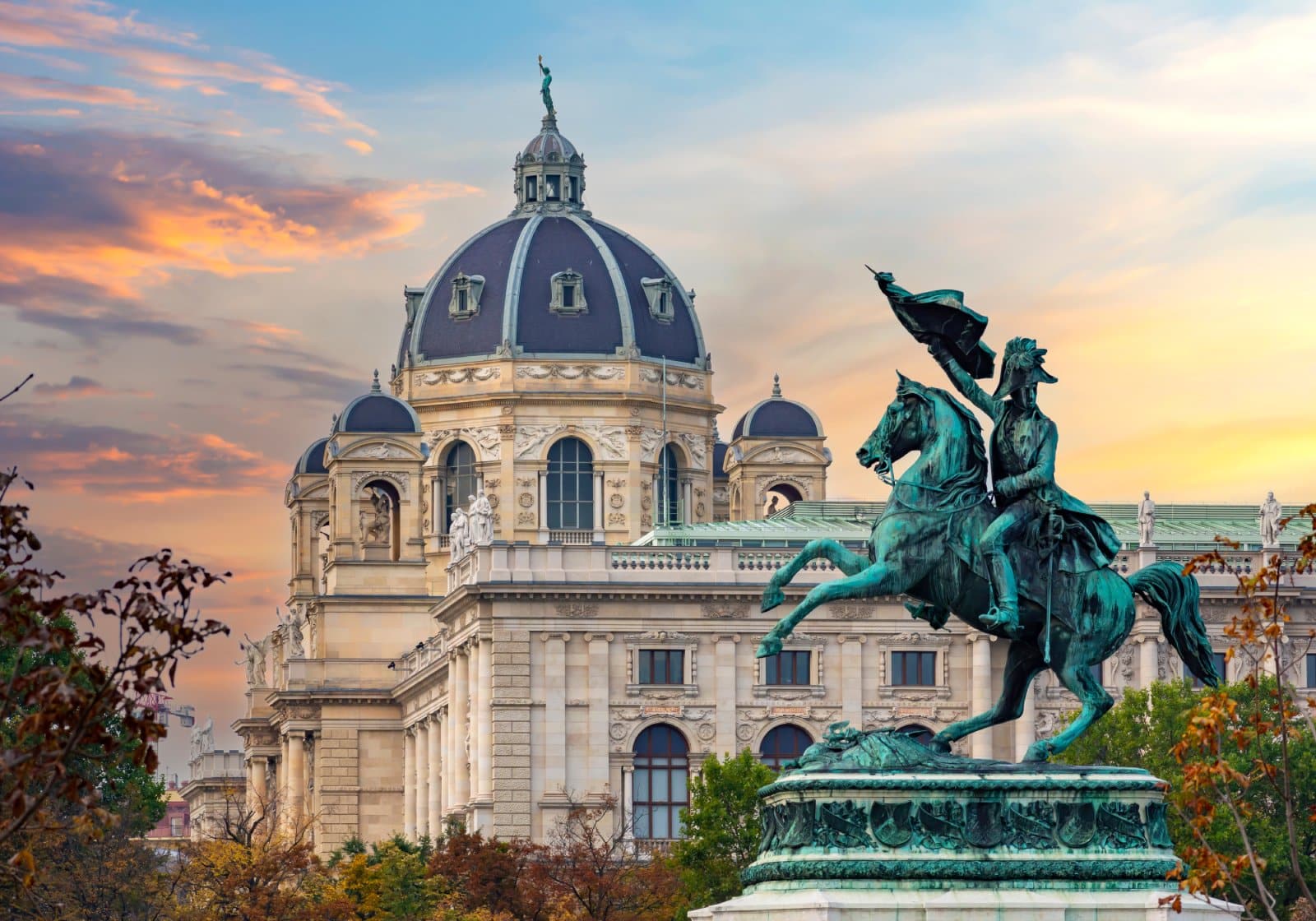
9. Vienna, Austria
Vienna’s grand imperial history and vibrant contemporary culture are best experienced on a bike. The city’s extensive network of bike paths takes you past historic palaces, through charming neighborhoods, and along the blue Danube. A bike tour in Vienna might include the Hofburg Palace, the Prater amusement park, and the trendy districts of Neubau and Mariahilf. Cycling in Vienna is a journey through a city that seamlessly blends its past with the present.
Insider’s Tip: Take a leisurely ride in the Prater, a large public park with a long, tree-lined main avenue perfect for cycling.
When To Travel: Spring and early fall offer pleasant weather and fewer tourists.
How To Get There: Vienna International Airport is the main gateway, with excellent public transportation links to the city center.
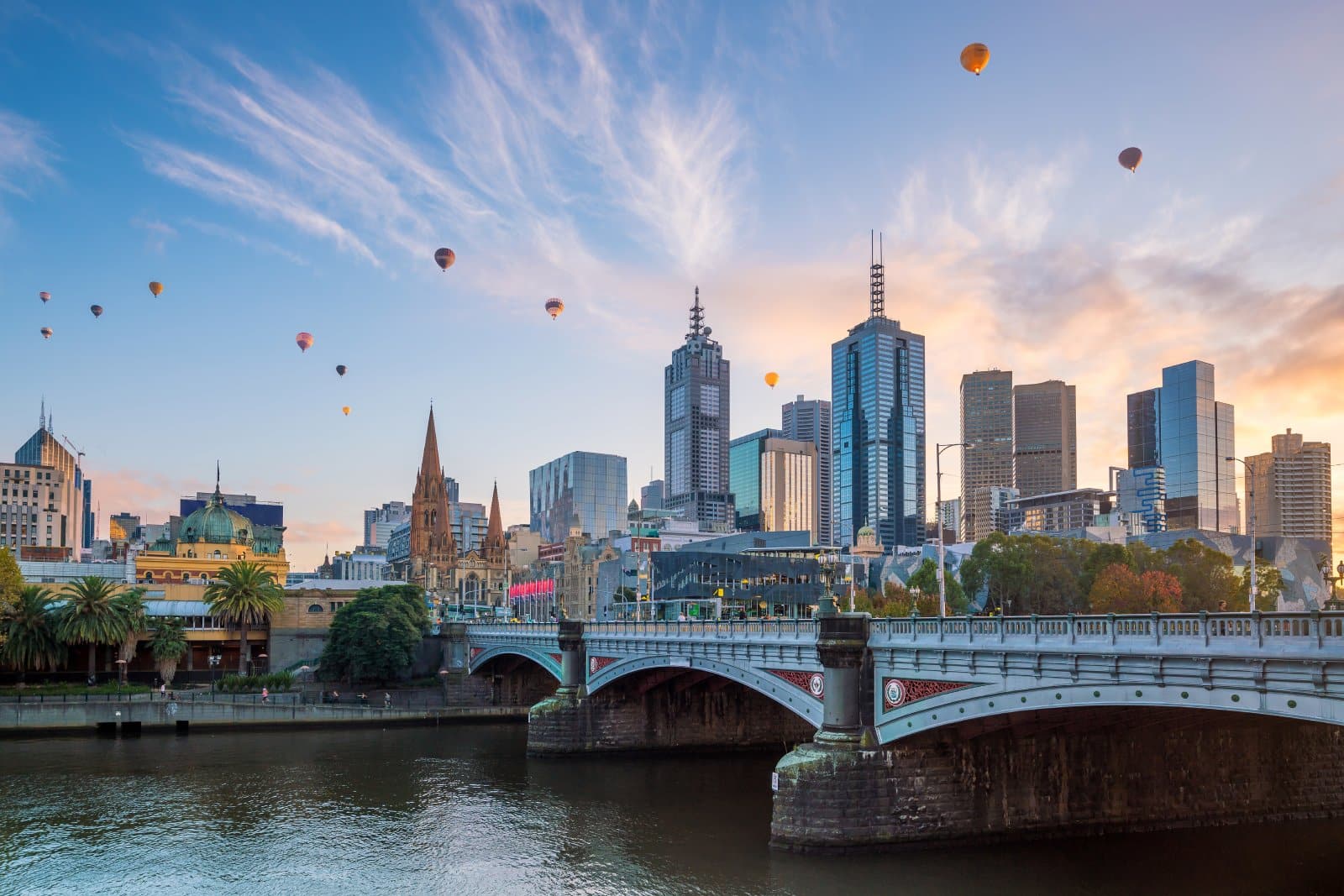
10. Melbourne, Australia
Melbourne’s eclectic mix of art, culture, and cuisine makes it an exciting city to discover by bike. A cycling tour here can include the artsy laneways, beautiful parks like the Royal Botanic Gardens, and the vibrant beachside suburb of St Kilda. Melbourne’s flat terrain and well-developed bike paths make it easy to navigate, and you’ll quickly discover why it’s often ranked as one of the world’s most livable cities.
Insider’s Tip: Explore the Yarra River trail for scenic views and a peaceful ride away from the city bustle.
When To Travel: Fall (March to May) and spring (September to November) offer the best weather for cycling.
How To Get There: Fly into Melbourne Airport. The city has a comprehensive public transport system, and bike hire is readily available.

The Bottom Line
Exploring cities by bike offers a unique perspective on urban landscapes and promotes a sustainable and healthy way of traveling. Each city on this list offers its own unique charm and attractions, best experienced at the leisurely pace of a bike ride. Remember, cycling tours are not just about physical activity; they’re about connecting with the city, its people, and its culture in an intimate and eco-friendly way. So, grab your helmet, hop on a bike, and start pedaling your way through some of the world’s most bike-friendly cities.
More Articles Like This…
Barcelona: Discover the Top 10 Beach Clubs
2024 Global City Travel Guide – Your Passport to the World’s Top Destination Cities
Exploring Khao Yai 2024 – A Hidden Gem of Thailand
The post Exploring 10 Cities Around the World by Bike – Pedal-Powered Discoveries 2024 republished on Passing Thru with permission from The Green Voyage .
Featured Image Credit: Shutterstock / PR Image Factory.
For transparency, this content was partly developed with AI assistance and carefully curated by an experienced editor to be informative and ensure accuracy.
More for You
Missing '1923' actor Cole Brings Plenty, 27, found dead in Kansas
Donald Trump Bond Rejected Due to Low Fee, Insurer Suggests
Barber Coins Are Worth Thousands: Here’s How To Spot Them in Your Spare Change
'The Rock' explains why he's not endorsing Biden this time, how he feels about 'woke culture'
30 slang words you may not realize came from TV and movies
Here's What Happens When You Keep a Car For Over a Decade
Joaquin Phoenix And 150 Hollywood Creatives Sign Open Letter Supporting Jonathan Glazer
The Exact Time to Quit Your Job, According to Chief HR Officer
6 Of The Worst Things To Order At Subway, According To Employees
7 CDs You Probably Owned, Threw Out and Now Are Worth Bank
27 Times Actors Made Mistakes On Set And They Actually Ended Up Being Genius Moments
US air force finds two causes in death of contractor who walked into propeller
Ex-Russian official issues warning about Putin
At 43, I’ve finally learned how to love my size 16 curves
Bring Life Back To Your Well-Loved Baking Sheets With This Medicine Cabinet Staple
4 Chain Restaurants With The Absolute Best Chicken Pot Pie And 4 With The Worst
Forgotten 1990s Blockbusters Everyone Should Rewatch
Bronny James, son of basketball great LeBron James, declares for NBA Draft
15 “As Seen On TV” Products That Are Well Worth The Money
Navy captain relieved for ‘loss of confidence’ following investigation
- For Media & Travel Trade

- About Kyoto
- Arts & Crafts
- Town & Architecture
- Temples & Shrines
- Eat & Drink
- Festivals & Events
- Accommodations
- Activities & Experiences
- Sustainable Activities
- Morning & Nightlife
- Itineraries
- Families with kids
- Travel Tips
- Destination Index

By using this site, you agree to the use of cookies. See our privacy policy for more information. This site uses machine translation, so content is not always accurate. Please note that translated content may differ from the original English page.

Tickets&Fares
- *Fares are roughly uniform in the city center, but fares may vary for riding certain sections of routes.
- Kansai One Pass and other IC cards can be used. There are sets for tourists which include 1-day passes for both subways and buses for 1,100 JPY (not usable on private railways), etc. See details here .

COMMENTS
The Sky Hop Bus is a red, double-decker, open-top sightseeing bus that offers tours around Kyoto where you can get on and off whenever you like. You can take in famous sightseeing spots right from your seat on its spacious and roofless upper deck. Gaze over Kyoto's beautiful scenery, get off at any sightseeing destination that grabs your interest, wander around, eat, play, and then get back on.
The "Sky Hop Bus" is a, double-decker and open-top sightseeing bus that offers tours around Kyoto where you can get on and off whenever you like. Get on and off SKY HOP tourist buses anywhere with a 1-day or 2-day pass. SKY HOP BUS KYOTO runs 12 departures per day. Timetable will change depending on the season, so please check the official ...
This Sky Bus tour of Kyoto provides an excellent introduction to Kyoto's major sites, and is also an enjoyable way to learn a little about Kyoto's history and culture. There are two separate tours: 90 minute "Drive Around" tour with no stops. 4 hour circuit of the city which stops at Kyoto's two most iconic sightseeing locations ...
1. Able to go to the main tourist spots in the city. 2. Adults can ride for 230 yen within the flat fare area! 3. Take advantage of the Subway & Bus 1-day Pass and travel around with subways as well. •Features. Kyoto city bus operates mainly in the suburbs of Kyoto City. Buses run frequently and connect to many tourist spots and stations.
There are various buses connecting the major sightseeing spots, including the No. 100 express bus which passes several sightseeing spots, the No. 200 bus that makes a circuit mainly on the major roads, and the Kyoto-Okazaki Loop Line. Buses have announcements and displays in English. Available from roughly 6:00 a.m.-10:00 p.m.
13. Sagano Romantic Train & Arashiyama, Kiyomizudera, Fushimi Inari Taisha Day Tour. 5. Historical Tours. 6+ hours. Enjoy an easy, culturally-enriching bus trip from Osaka to Kyoto. The tour starts with a magical train ride on the Sagano…. Free cancellation.
K'LOOP is the tourist loop bus for exploring popular tourist attractionsincluding the World Heritage Sites in Kyoto. ... Purchase a one-day pass from the bus information attendant at the Hachijo Gate of Kyoto Station or from the bus crew. Payment by cash, WAON, LINE Pay, PayPay is possible. We can't accept payment by credit card and so on ...
Contact number:+81-75-286-8844. JR Kyoto Station, Karasuma Exit. Shimogyo-ku Higashi-Shiokoji machi 909, Kyoto sightseeing bus terminal. Please refer to the map for assistance. Nearby landmarks: from the Kasasuma Exit of Kyoto Station on the JR Line, there is a bus terminal on the left side.
Full description. Discover the highlights of Kyoto with a same-day or 2-day ticket on this convenient hop-on hop-off sightseeing bus. Admire the panoramic views from onboard the open-top double-decker bus, and hop on or off at any of the stops along the route. Enjoy informative audio commentary on board the bus, available in 7 languages.
News! The total ridership of K'LOOP exceeded 100,000. In commemoration of this, the fare were discounted to 2300 yen for adults and 1000 yen for children. (Audio guide receiver rental fee, 500 yen, is included.) The only bus system of its kind in Kyoto, K'LOOP allows you the freedom to enjoy World Heritage sites and other important cultural ...
Familiarize yourself with the Kyoto bus system to travel around the city conveniently. Understand bus maps to plan your routes efficiently and avoid getting lost. Use Kyoto City buses effectively by learning about routes, schedules, and fares. Follow tips for riding Kyoto City buses smoothly, such as preparing exact change and boarding etiquette.
Kyoto travel guide: Raku bus cost. A single ride on the Kyoto city bus will cost you 230 yen for adults, and 120 yen for children under the age of 12. You board in the back with payments being made when you get off the bus at the front. Exact fare is always preferred, but there is a change machine available so you don't need to worry too much.
🚌 Kyoto buses: network maps, pros and cons. Click on the picture to display it full size. Kyoto buses have some advantages: Since buses use the well-developed Kyoto street and road network, they can cover most tourist destinations; They run quite frequently on the most used lines;
The bus covers parts of the city that trains don't reach. Many of Kyoto's most popular attractions - including Kinkaku-ji and Ginkaku-ji temples - are not located near train or subway stations, and the bus is the ideal option to bridge the gap. Kyoto has a wealth of bus routes operated by a few different companies, and most make announcements in both English and Japanese.
The Kyoto City Bus One-Day Pass allows for unlimited travel on all Kyoto city buses and Kyoto buses within the downtown fixed rate zone (including Arashiyama and Shūgakuin ) and costs 700 yen for adults and 350 yen for children. The Kyoto City Bus One-Day Pass is available from the Kyoto Station Tourist Information Center, subway station ...
Kyoto Sightseeing Bus & Kyoto Sky Bus. "Kyoto Sightseeing Bus" and "Kyoto Sky Bus" that tour the main tourist spots in Kyoto are recommended for those who want to tour around Kyoto without the hassle of transferring between buses or trains. The on-board multi-lingual audio guide in English, Chinese and Korean can provide description of the ...
Todaiji temple Greta Buddha, Nara deer park, Arashiyama and some more. From 17,500 JPY. BOOK NOW. Enjoy the Essence of Spring in Kyoto 1 Day Bus Tour. Experience the essence of spring in Kyoto with the ultimate lineup: "Randen Sakura Tunnel," "Arashiyama," "Kodai-ji Temple Illumination,". From 11,900 JPY.
Kyoto/Arashiyama 1-day pass. (Hankyu Railway/Keifuku Railway (Randen)/Kyoto Bus (Arashiyama/Sagano areas)) Keihan Railway KYOTO-OSAKA SIGHTSEEING PASS 1day. (Keihan Railway) Subway & Eiden: Kurama/Kibune day trip ticket. (Eizan Railway/Subway/Keihan Railway (partial)) Eizan Railway 1-day ticket "Ee Kippu". (Eizan Railway (Eiden)) Kyoto ...
The Kyoto City Bus & Kyoto Bus One-Day Pass is 600 yen for adults and 300 yen for children. This gives you one day's unlimited travel on Kyoto City Bus and Kyoto Bus routes within the flat fare zone. The Kyoto Subway & Bus Pass covers all Kyoto City buses, all Kyoto Municipal Subway trains and some buses run by the Kyoto Bus and Keihan Bus ...
If you plan to use the bus a lot, you should probably buy yourself a bus pass. For more details, see our Special Kyoto Bus, Train and Subway passes page. Arm yourself with an English-language bus map. The map is called: Bus Navi: Kyoto City Bus Sightseeing Map. Pick up a hardcopy version of this map at the Kyoto Bus Information Center, just ...
The Tourism Express Buses will run on weekends and holidays, with both routes starting at Kyoto Station.The longer route, designated EX100, will depart from Kyoto Station and head east into the Higashiyama district, with its first stop at Gojozaka, down the hill from Kiyomizu Temple.The bus will then travel north to its next stop at Gion, Kyoto's famed geisha quarter, and then to a combined ...
Kyoto is considering special tourist express bus routes, that will whisk visitors to the city's most iconic sites in order to reduce overcrowding and improve efficiency on regular local buses, as well as to make what can be a complicated system easier for travelers. ... For example, Kyoto's famous golden temple Kinkaku-ji costs ¥400 for ...
You will arrive in Kyoto in approximately 100 minutes. These buses are affordable and go directly to Kyoto.-----Jumbo taxi / fixed price taxi: Travel time depends on destination "Comfortable [Recommended for people like this] ・Those who want to travel door to door from the airport to their destination ・Those with a large number of travelers
6. In Kyoto one takes a bus to move around. Easy and quite fast. Fixed charge for adults is J yen 230 for each trip on board. Any number of stops for 1 trip. IC card can be used. Only exact 230 fare to be paid in cash. No return of cash if excess paid. Driver has no cash to return. Some buses will have a cash coin vending machine near the driver.
Ace Hotel Kyoto. The youthful Ace hotel brand might seem like an odd fit in staid Kyoto. But this 213-room property, which opened in 2020, fits seamlessly into the city center thanks to a ...
When To Travel: Spring for cherry blossoms and fall for colorful foliage. How To Get There: Fly into Kansai International Airport and take a train or bus to Kyoto. Bike rentals are readily ...
The fare for adults starts at 230 JPY per ride. The fare for children starts at 120 JPY. *Fares are roughly uniform in the city center, but fares may vary for riding certain sections of routes. Kansai One Pass and other IC cards can be used. There are sets for tourists which include 1-day passes for both subways and buses for 1,100 JPY (not ...